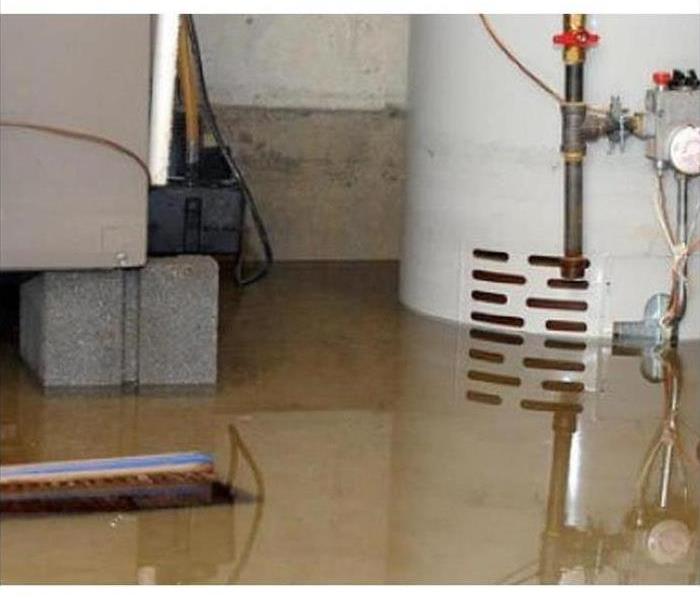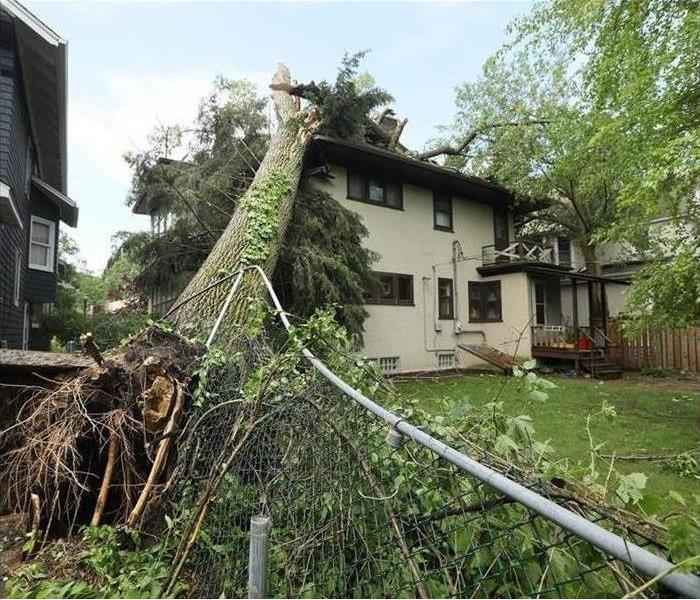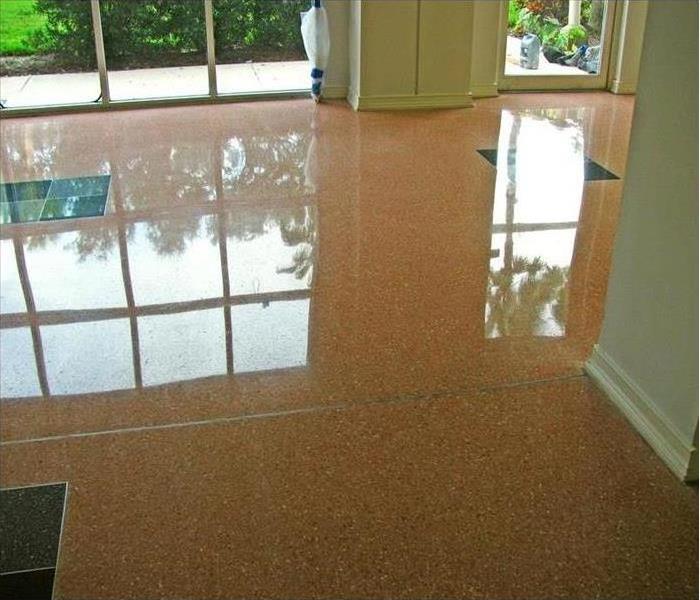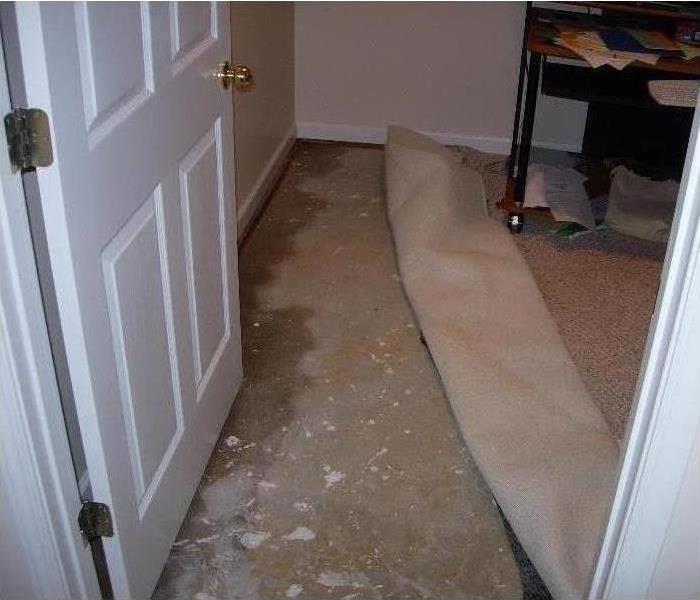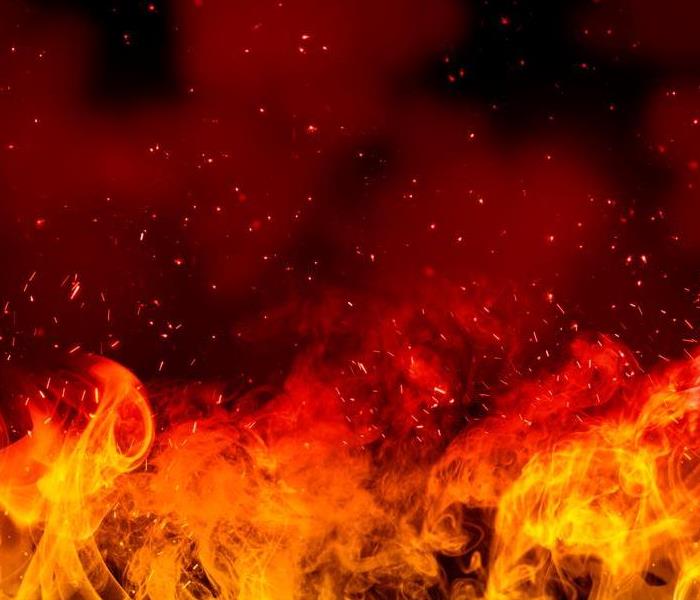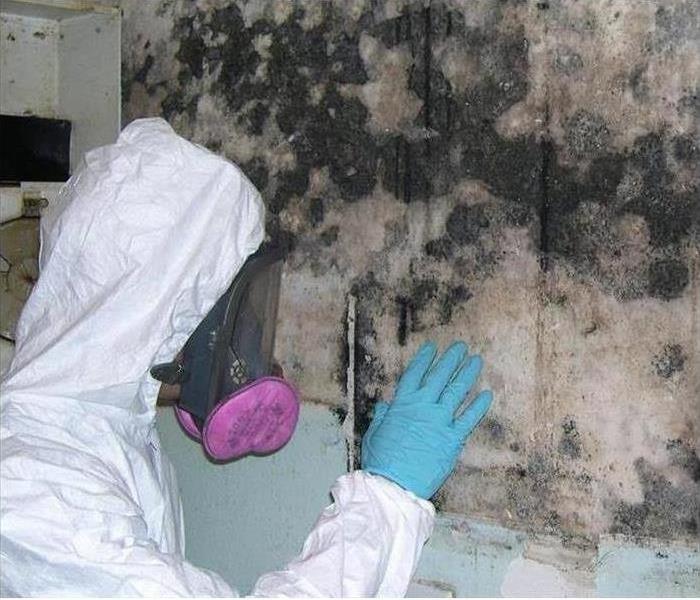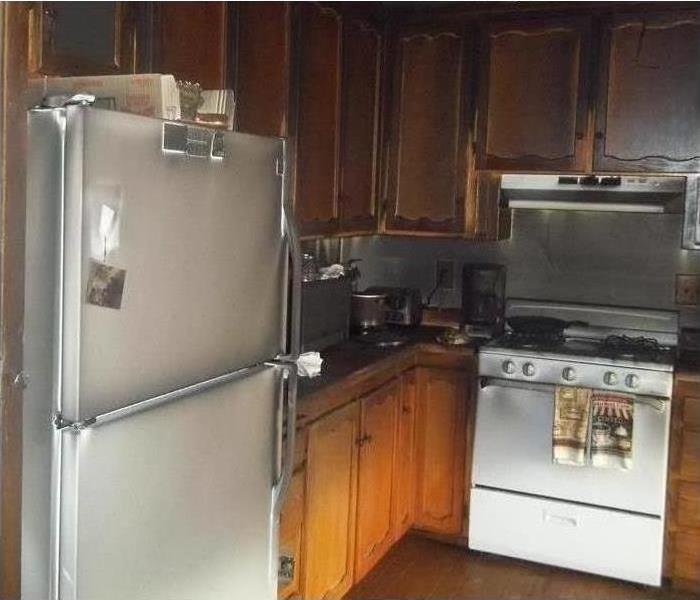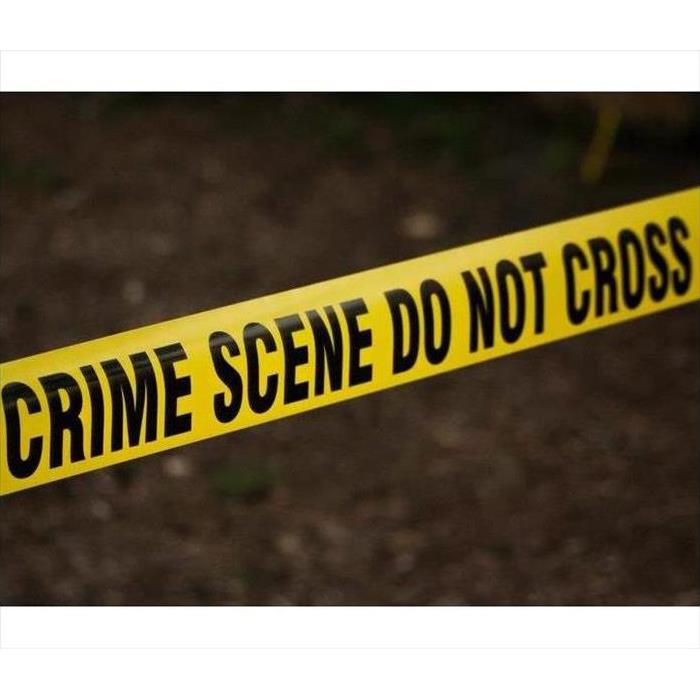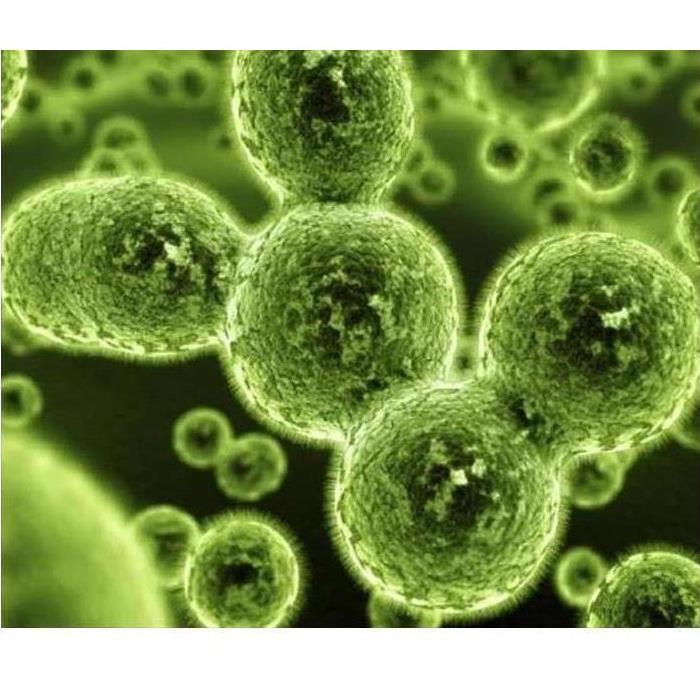Archived Blog Posts
Can your Business Survive a Flood?
10/19/2022 (Permalink)
Floods are unavoidable and when disaster strikes, you need to be prepared. This is best achieved by planning in advance and knowing how to deal with the aftermath once the flood has occurred. Below are a few tips on how to prepare your business for a flood before it happens and what to do after it has struck.
Devise a flood plan
Whether you are expecting a flood or not, one of the most important things to have in place is a thought-out flood plan to help reduce the damage caused to your business or property. Your flood plan should cover the following aspects:
Staff
In the event of a flood, you need to make sure your staff are not only fully informed of the plan in place, but understand the risks involved. If you are expecting a flood to strike, it may be worth sitting down as a team and working out the best way to approach the situation.
Equipment
If you work in an office then it is likely that you will have computers or some form of electrical equipment; this can pose a huge risk when it comes to floods so it is important that you include such equipment and risks in your flood plan. The best thing to do is listen out for any news about the flood and whether it is predicted to reach your premises any time soon. If the flood is close to your business, it might be worth switching off all of the electrical equipment and moving it to higher, safer locations before evacuating the building. This way you not only ensure the safety of your employees, but you also reduce the chance of suffering expensive equipment damage and loss.
Sandbags
Sometimes it is impossible to predict sudden events or evacuate the building before disaster hits. Therefore, it is vital that you are prepared for the flood striking when you least expect it. Sandbags can be incredibly useful in a flood, so you should have some spare just in case. Not only can they help to barricade the flood's entry points i.e. the door where the flood is coming in, they can also filter a few sediments commonly found in flood waters.
Dealing with the aftermath
The results of a severe flood can be devastating for everyone. Floods can change the lives of homeowners and entire families. In the business world, flood can affect everything from property safety to business operation, which in turn can put people's livelihoods at risk. This is why it is vital that if you are expecting a flood you have someone who can help you deal with the aftermath and restore your business as soon as possible.
Here at SERVPRO, we offer a fire and flood restoration service that focuses on providing those affected by floods have a stress-free experience when it comes to cleaning up and getting business back to normal a quickly as possible.
Should you encounter flooding at your business, call the professionals at SERVPRO. We will help you get your business back up and running as quickly as possible.
Know The Facts About Business Fire Restoration
10/18/2022 (Permalink)
Know the Facts about Business Fires
According to the U.S. Small Business Administration, as many as one in four businesses that suffer some kind of major disaster do not reopen afterward. It’s true, overcoming a major loss is extremely difficult, but with the right restoration company and team on your side, working hand-in-hand with your insurance company, the chance of your Indianapolis-area company surviving is pretty high!
Depending on the size of the fire, and the amount of damage, some businesses that have come to SERVPRO for help have reopened just days after the fire happened. Thanks to innovations in smoke odor removal, fire damage restoration, and cleaning in general, it is possible for crews to start work nearly immediately after the fire department clears the scene, and have things back up and running in no time. Although, again, that all depends on the severity of the fire. But no matter the severity, recovery is possible!
According to the National Fire Prevention Association, U.S. fire departments responded to about 3,300 office property fires per year between 2007 and 2011. Those fires resulted in about $112 million in property damage each year, and most were in business offices – and happened during business hours. However, the good news is the number of business fires was down a whopping 71 percent from 1980 to 2011.
Here are some other stats from the NFPA:
Time of Day
- Peak time of day for office fires: Noon – 2p.m. (a.k.a. lunch time!)
- 69% happened between 7 a.m. and 7 p.m.
- The 31% that occurred between 7 p.m. and 7 a.m. caused 67% of recorded property damage, because they went undetected longer. This also highlights the need for automatic detection equipment and working sprinkler systems.
- 19% of fires happened on weekends.
Cause of the Business Fires
- 29% were caused by cooking equipment. However, just 6% of these fires caused actual property damage.
- Intentionally-set fires caused the most direct property damage – 21%.
- Electrical equipment is the second leading cause of office fires.
- Just 2% of office fires start in a concealed space like an attic, in the ceiling, or in another conceals space. However, these fires accounted for 13% of the direct property damage.
Containment & Putting it Out
- 4 out of 5 fires were confined to the room of origin.
- 90% of fires were large enough to activate sprinklers, which were effective 88% of the time.
- Deaths per 1,000 stores were 62% lower in offices equipped with sprinklers compared to those without.
Industrial/Manufacturing Facility Fires
The NFPA also has statistics specific to manufacturing facilities. According to their research, there are about 37,000 fires at industrial or manufacturing facilities each year, resulting in 18 deaths, 279 injuries, and $1 billion in property damage. Heating equipment and stop tools were the leading cause – sparking 28 percent of the fires. Mechanical failure or malfunction caused 24 percent of the fires.
Planning for the Worst
As part of your emergency preparation plan, be sure to have a local, reputable restoration company – like SERVPRO– on speed dial. The sooner you get the professionals in cleaning up after the disaster, the sooner you can get back to business!
Fun Storm Facts
10/3/2022 (Permalink)
Are you afraid of storms, or do you embrace them? Whichever side you fall on, we all have some sort of respect for storms. They can cause great damage, paint beautiful pictures across the sky, alter any outdoor plans, and completely turn a day around. Although you’ve probably experienced many thunderstorms in your life, you might not know a whole lot about them. In today’s post, we’re going to share some fun storm facts that you may not have known!
- The typical thunderstorm is 15 miles in diameter!
- The typical thunderstorm lasts about 30 minutes.
- About 1,800 thunderstorms are happening around the world at any given moment.
- Lightning kills more people than tornadoes every year.
- A severe storm “watch” means that a serious storm has the potential to develop, but has not developed yet. However, a sever storm “warning” means that a storm has developed and been sighted.
- About 10% of storms are classified as “severe”.
- If you’re ever heard the term the “four horsemen” of thunderstorms, it’s referring to wind/tornadoes, hail, floods, and lightning.
- Thunderstorm clouds grow to heights of above 20,000 feet!
- A “derecho” is a type of severe storm that lasts a long time, covers a great distance, and involves serious wind.
- Wind speeds can be up to 120 mph in thunderstorms, even without a tornado.
- A massive hailstorm in Munich, Germany, in 1984 caused over $1 billion worth of damage.
- In 1933, huge hailstones were reported to have fallen around a city in Massachusetts, containing fresh, frozen ducks inside.
Storm Facts, Tips & Safety
9/26/2022 (Permalink)
Severe Thunderstorm Facts
Thunderstorms are defined as storms that produce thunder and lightning. Severe thunderstorms may also produce:
- Rain
- High winds
- Sleet or snow
It’s important to note that thunderstorms do not always produce moisture. A storm in which you see lightning and hear thunder but never feel a drop of water is known as a “dry” thunderstorm. Thunderstorms that produce hail and tornadoes are known as “supercell” storms. Storms occur either in clusters or lines; therefore, they may present as a single thunderstorm or as multiple thunderstorms hitting one after the other.
Causes
Thunderstorms are caused when moisture from the lower or mid-level part of the atmosphere mixes with warm, unstable air from the ground. Moisture and air then push upwards into the higher atmosphere to form clouds that produce thunder and lightning, as well as potential precipitation. Spring, summer and fall are most conducive to thunderstorms because the sun heats the ground and moisture is more perceptible in the air, especially in humid climates.
Thunderstorms must also be lifted to begin their formation. Some sources of lift include:
- More heat on the ground than in the air
- Changes in atmospheric conditions near mountains
- Weather front changes caused by clashing cold and hot air
- Drylines, or when moist and dry air clash
- Land or sea breezes
Any of these situations can immediately create a thunderstorm without warning, even in the middle of a clear blue day. In many cases, these storms will also be accompanied by lightning. Most will not come with hail or tornadoes, unless they occur in tornado-prone states such as Kansas, Oklahoma, Texas and Missouri.
Thunderstorm Statistics
Severe thunderstorms are responsible for a significant number of injuries, fatalities and property damage claims across the United States every year. According to statistics reported by the National Oceanic and Atmospheric Administration (NOAA) in 2013:
- Lightning accounted for 23 fatalities, 145 injuries and $23.9 million in property damage.
- Tornadoes caused 55 fatalities, 756 injuries and $3,642.2 million in property damage.
- High winds resulted in 17 deaths, 121 injuries and $626.8 million in property damage.
- Hail led to 4 injuries and $1,234.5 million in property damage.
- Flash flooding ended in 60 deaths, 25 injuries and $956.9 million in property damage.
It’s estimated that at least 867,000 people are affected by thunderstorms every year, with lightning accounting for at least 300 injuries and roughly 60 fatalities. Moreover, at least 16 million thunderstorms occur worldwide every year — and at least 2,000 storms are causing damages and injuries around the world at any given time.
Preparing for Severe Thunderstorm Conditions
Severe thunderstorms can cause significant physical harm as well as damage to your home and land; therefore, it’s imperative to take measures to protect yourself. Some homeowners might invest in lightning rods to better defend their homes against a surge. There are also whole-house surge protectors so you don’t have a power outage during a severe thunderstorm. There are many other types of defenses you can put in place to protect your home against severe thunderstorms. For example, here’s how to prepare for hail, winds, tornadoes and floods.
Hail Damage
If you have a car, it’s imperative that you park it in your garage before a severe thunderstorm. Otherwise you could be looking at dents, cracks in the windshield and potentially broken glass on the driver or passenger’s side. While hail is not the most common precipitation to accompany a severe thunderstorm, it can happen. You could also:
- Install wind shutters (i.e. hurricane shutters), designed to defend against high winds and hail.
- Purchase & install pressure or high impact windows.
- Secure doors with heavy-duty bolts at the top and bottom of the door frame.
Hail can cause damage to many parts of the home, but it most commonly hits the roof the hardest. A damaged shingle, in particular, can allow water to get through to the roof deck and cause harm to your ceiling and support beams. This will eventually lead to more leaks in your roof, stains on the ceiling and walls, and potential flooding.
The cost to repair a roof following such damages will be expensive, but holding off could lead to even more costly repairs down the road. It’s best to perform repairs as quickly as possible. The two types of repairs you might be faced with include:
- Asphalt: Hail damage will appear as a dark spot or bruise because the granules will be missing. Look for holes, cracks or absent shingles. Repair immediately.
- Other shingles: Wood, metal, tile and other shingles will be hit hard by hail as well. Cracked, missing or broken shingles will allow leaking, so you’ll need a roofer in immediately to fix the problem.
Wind Damage
Winds can reach at least 300 miles per hour during a severe thunderstorm, which can rip siding off your home and exacerbate the pelting of your exterior with hail and debris as well. Wind damage repairs can cost thousands of dollars, depending on the extent of the injury. While you can’t prepare for flying debris from other houses, you can minimize damage by curtailing debris in your own yard. To prevent wind damage, you can:
- Trim back tree branches to prevent fallen limbs.
- Secure window shutters to defend against debris.
- Tie down anything that could fly away and hit the siding or the roof.
If your siding is looking worse for wear, have a siding professional come out to repair it. It could make the difference in whether you’re left with an intact home exterior after a storm or not.
Tornado Damage
Tornado damage occurs following high winds from blowing debris. While you can’t do a lot to prepare your home for a tornado, it helps to trim tree branches back from your roof and windows. You can also reinforce your roof to better handle high winds:
- Shake roof: Add more nails.
- Slate roof: Seal down with cement.
- Tile roof: Place a steel strap over the tiles.
- Asphalt roof: Nothing can be done, but inspect after.
You can also invest in a storm cellar, which is built underground and allows great defense against high winds during a tornado. A storm shelter is built close to the home so you have easy access during a tornado and don’t have to run far for safety. A storm cellar door is built at an angle so that debris blows over the door. This allows for debris to roll over the door rather than trap it, so you can get in and out easily. The confines of a storm cellar for a family is around 8 by 12 feet with an arched roof. It’s made of cement blocks and rebar to ensure maximum defenses.
Flood Damage
Flooding can cause tens of thousands of dollars in damages to your home. To prepare your home for potential flooding, ensure that the ground is sloped away from your foundation. This will defend your home against water buildup. Also, regularly maintain any storm drains, gutters and downspouts. Other tips include:
- Cleaning gutters regularly
- Check and clean storm drains on a bimonthly basis
- Clean the storm drain cover
- Check window wells and sump pumps
- Construct barriers to stop flood water from getting into your home.
- Raise your heating system to a higher floor level to avoid flood water.
- Seal cracks in the basement walls.
Warnings, Alerts & Where to Go
You will see severe thunderstorm warnings and alerts appear throughout the span of the storm, whether it’s on the radio, TV or your smartphone. You can find warnings:
- In emergency notifications on smartphones
- On weather apps as alerts in real time
- On the radio from the National Weather Association
- On TV at the bottom as a grey moving bar with affected counties, times
When you see a severe thunderstorm warning in effect for your area, you need to stay indoors until at least 30 minutes after the last clap of thunder. Stay away from windows and doors, in case they happen to blow open or break in high wind conditions. Stay out of water in case of lightning. If you’re driving when you get the alert, head home if you’re close or get off the road immediately.
Storm Recovery and Damage Repair
After a severe thunderstorm hits your home, you could be looking at a few hundred dollars worth of simple repairs — broken windows, landscape upkeep and debris removal, for example — or you could be looking at thousands of dollars in repairs due to hail damage and flooding. Survey the extent of the damage and determine whether it will cause additional long-term issues; immediately fix anything that will. Here are some common post-storm damages and how to address them:
Roof Damage
Broken tree branches, high winds, flying debris and hail can cause roof damage that will need to be addressed following a severe thunderstorm. Some signs of roof damage after a storm include:
- Holes
- Split seams
- Missing, bruised or dented shingles
- Cracked or broken tiles
- Granules in the gutters
- Leaks
- Dents on the vents and gutters or roof flashing
It’s imperative that you have a roofing contractor fix your roof following a severe thunderstorm. Otherwise, these damages could lead to expensive interior problems like attic flooding, ceiling stains, and mold. In worst-case scenarios — those in which your roof is old and cannot handle the high winds or hail storms — your roof may cave in on itself. This is uncommon, but you do run the risk of having to replace your roof if it’s reaching the 15-20 year mark around the time of a severe thunderstorm.
Siding
Weather associated with severe thunderstorms can also significantly impact the exterior and siding of your home, causing:
- Cracks that run parallel to the siding
- Chips or breaks in siding
- Breaks or holes that are punched into the siding by hail and debris
- Dings and dents, most commonly found in aluminum siding
- Paint damage such as chips, cracks and color changes or small black marks
If your siding shows cracks, chips, or dings and dents, have it repaired immediately to prevent pests, insects or climate conditions from further impacting your home. Breaks and holes, in particular, negate the siding’s ability to defend your home entirely. Such damage will require siding to be replaced by a contractor — in parts or in whole — which could cost thousands of dollars. Paint damage is the least of concerns because it’s a cosmetic injury rather than a functional one.
Windows and Doors
Windows and doors bear the brunt of severe thunderstorms’ debris and high winds, making them highly susceptible to damages. Some damages you’ll see after a storm might include:
- Cracked or splitting doors and frames
- Broken glass or shattered windows
- Debris embedded in a door or window
- Paint chipped or cracking around a door or window
Contractors recommend taking the following steps to protect your windows and doors against severe thunderstorms.:
- Window film: This keeps window glass from shattering.
- Plywood boards: Install over windows before a storm.
- Storm shutters: Shutters defend against high winds and debris.
- High impact glass: Impact glass breaks into two pieces rather than shattering when hit by debris.
Tree Damage
While you can trim your trees back before a storm, there’s still a chance that high winds, flying debris and hail will cause them to bend, twist and break during a severe thunderstorm. There are six different ways a tree can be damaged during a storm:
- Blow-over: A tree is pushed over by high winds.
- Stem failure: Stems break under high winds because of old wounds and pest damage.
- Crown twist: Tree crowns will twist and split under high winds because of poor maintenance, or because they’re lopsided.
- Root failure: Poor anchorage to the ground will cause the root to pull up or snap, and the tree will fall or lean over.
- Branch failure: Branches will break off from the tree because they’re poorly attached in the first place.
- Lightning: Lightning will hit the tree and cause small explosions down the line of the tree, causing it to break and fall.
There’s not much a homeowner can do to prep a tree for potential damage except provide good care and maintenance. Trim trees on a regular basis and try to keep branches away from your home and power lines.
Flood Damage
If your home is flooded following a severe thunderstorm, there are various steps you can take to recover your home. It’s going to be a long process, involve a lot of tearing up, remodeling and time, but your home will go back to its original state eventually. Some recommendations from the CDC include:
- Wear safety gear.
- Get rid of anything that can’t be cleaned (bedding, fabric flooring, upholstery, toys, linens)
- Throw away drywall and insulation that’s wet.
- Deep clean and scrub hard surfaces with hot water and dish detergent.
- Use fans, A/C units and dehumidifiers to speed the drying process.
- Wash all clothing touched by flood water with hot water and laundry detergent.
Be aware of electrical power lines, natural gas lines, frayed wires and any other hazards from flooding that could injure you. You should check with the gas company or the fire department before returning to your home to avoid injury. Do not return to your home during the day to avoid any accidents from being unable to see. You shouldn’t be allowed to return until the police or fire department say it’s okay. You should also not wade in standing water or around downed power lines, just in case.
If you need help with the big part of the recovery job — pulling up carpet, taking down drywall, removing appliances, so forth — you can call in a disaster recovery contractor to help you. These professionals are licensed and experienced in handling situations like flood recovery and know where to start. They can also look out for disaster-specific issues like mold, foundation issues and the like.
Top States for Thunderstorms
Some states are more prone to severe thunderstorms than others, which means homeowners in such states need to be better prepared. According to a report on WeatherBug, in 2013 the top states for severe thunderstorms between March 1 and June 17 included:
- Texas: 922 events*
- Oklahoma: 725 events
- Kansas: 652 events
- Missouri: 515 events
- Illinois: 456 events
- Nebraska: 405 events
- Iowa: 403 events
- New York: 252 events
- Mississippi: 233 events
- Virginia: 232 events
- Louisiana: 223 events
*Note: events are defined as severe thunderstorms
The most active states — Texas, Oklahoma, Kansas and Missouri — received 300 severe thunderstorm alerts per week.
Thunderstorm Safety Tips and Prevention
To keep your home and family safe before and during a thunderstorm, it’s imperative that you take precautionary measures — especially if you live in an area prone to storms.
To prepare for a thunderstorm, the Federal Emergency Management Association (FEMA) recommends:
- Putting together an emergency kit and family plan
- Removing debris and branches
- Securing outdoor objects that could blow away or damage the home
- Staying inside your home
- Closing all exterior windows and doors
- Unplugging all electronic equipment before the storm.
While there isn’t much you can do to prevent a severe thunderstorm, you can keep the damages to a minimum by securing as much in your home as possible and reinforcing the defenses around your home exterior. Tie down your roofing or seal it with mortar, call in siding professionals and clean up all the debris around your house.
There are storm damage professionals who can come in following a natural disaster and help with the recovery. While they don’t fix everything, they can help you start the process. If you want to read more about what they do, read this FAQ from the National Storm Damage Center.
How to Keep Your Insurance Down
Standard homeowner policies cover your home and what’s in it. You should be covered for storm damages and major natural disasters, including severe thunderstorms; however, flooding is not generally covered. Storm-resistance improvements that will lower your premiums include:
- Impact-resistant shingles
- High impact glass
- Storm shutters
Always file a claim following a severe thunderstorm if your home is extensively damaged.
Cost Effective Water Remediation
9/20/2022 (Permalink)
Many steps can be taken to make the restoration and repair of a flood-damaged home more efficient and cost-effective.
Understanding the full measure of the flood restoration process for your home can ensure that the appropriate professionals get called to respond to these disasters when necessary. Flood restoration involves multiple repair and cleaning stages, both of which our extensive roster of qualified professionals can provide. Understanding what is involved in returning your home to a preloss condition after a flood can show homeowners how vital professional recovery actually is for residences and businesses alike.
When considering how extensive flood damage inhomes can become, containment and emergency services become vital efforts to begin immediately. Often, these preliminary tasks occur before mitigation or the job scoping phase. Planning is a considerable step and stage before restoration begins, but there are specific actions they cannot wait to be included in this overall restoration agenda. We have several efficient strategies beginning with your communication with our staffed SERVPRO emergency line.
When is the Information About the Disaster Gathered?
As you might expect, our professionals cannot know about damages to your specific residence without first notifying our administrators about the issue. The information you share with our staff emergency line representatives is shared directly with the appropriate parties responding to the disaster. At this stage, it is critical to be as thorough as possible so that we can collect the proper data and relevant facts to ensure that our technicians mobilize from our warehouse with the right equipment, personnel, and products. There are three ultimate ways that we collect the bulk of the data necessary to form our restoration plan for the property:
- Emergency Phone Call – As already discussed, the more that you can share with operators on our emergency line, the better prepared our technicians are for what to expect when we reach the property.
- Job Scoping – We have highly trained project managers who walk through the property damaged by a flood to determine what actions must be taken to restore the home. We can also use this phase to document total losses of structures and contents or indicate where further measures might be required in these areas.
- Conversations with the Customer – No one knows your property as well as you do, so we often lean on the information provided by our customers to prioritize what actions get taken first.
What is a Staging Area?
One of the efficient recovery approaches that our SERVPRO technicians utilize is staging areas. These get constructed in unaffected areas of the home nearby to where the bulk of the work and cleaning must occur. The objective of establishing a clean room to store equipment and personal protective gear is to have these items accessible as they are needed. We can limit trips in and out of the house by bringing in all of the necessary equipment, products, and devices into this staging area. The primary advantages of establishing this clean room between your home and its damaged areas are:
- Efficient
- Convenient
- Prevents Cross-Contamination
- Near to Drying/Work Zones
What Are Efficient Strategies for Extraction?
Flood losses can be traumatic events in your house, specifically when standing water becomes a pressing concern. In any capacity, pooling can lead to saturation and absorption into the exposed materials of contents nearby. Extraction becomes a critical effort for our responding technicians because this removes the standing water threat to allow for more focus drying, cleaning, and other recovery actions. There are several extractors common to removing natural flood water from a property, whether inside the house, in the crawl space area, or even more inaccessible locations. These approaches include:
- Trash Pumps – Gas-powered trash pumps can often be an ideal choice for removing natural flood water because of these units’ ability to remove smaller solids and debris.
- Wet Vacuums – Extractors like wet vacuums are a more versatile choice, as these can run several different attachments such as carpet wands, squeegee wands, or work independently to remove water below two inches in depth.
- Subcontractor – Threat of contamination can be a motivator to choose a subcontractor where blackwater incidents might be overwhelming for the equipment available to our SERVPRO team.
Many initial tasks must occur between the potential for contamination and leftover bulk materials immediately following the disaster. Our team has motivated and helpful water restoration technicians and cleaning specialists to help address drying and restoring the property “Like it never even happened.”
Severe Weather Facts and Myths
9/19/2022 (Permalink)
Myth: Highway and interstate overpasses are safe shelters against a tornado.
Fact: Overpasses can concentrate the tornado winds, causing them to be significantly stronger. This places the people under them in an even more dangerous situation. In recent years, several people seeking shelter beneath overpasses have been killed or severely injured. Being above ground level during a tornado is dangerous.
Myth: The low pressure with a tornado causes buildings to explode. Opening the windows will equalize the pressure, saving the building.
Fact: Opening the windows in an attempt to equalize pressure will have no effect. It is the violent winds and debris that cause most structural damage. It is more important for you to move to a safe area away from windows and exterior walls. With a tornado, every second counts, so use your time wisely and take cover.
Myth: Thunderstorms and tornadoes always move from west to east.
Fact: More often than not, thunderstorms move from west to east. Conditions in the atmosphere dictate how and where storms will move, and it can be in any direction. Tornadoes have been known to act erratic, and can change directions and speed very quickly. Never try to outrun a tornado in a vehicle.
Myth: It’s not raining here, and skies above me are clear, therefore I am safe from lightning.
Fact: Lightning can strike many miles away from the thunderstorm. If storms are in your area, but skies happen to be clear above you, that certainly does not imply you are safe from lightning. Though these “Bolts from the Blue” are infrequent, lightning strikes 10 to 15 miles away from the storm are not out of the question.
Myth: Since I am inside my house and out of the storm, I am completely safe from lightning.
Fact: Just because you have taken shelter inside, you are not automatically safe. While inside waiting out a storm, avoid using the telephone or electrical appliances and do not take showers or baths. Also stay away from doors and windows. Telephone lines, cords, plumbing, even metal window and door frames are all lightning conductors and pose a threat
Myth: Large and heavy vehicles, such as SUVs and pickups, are safe to drive through flood waters.
Fact: It is a common belief that the larger the vehicle, the deeper the water it can drive through. Many people do not realize that two feet of water can float most vehicles, including SUVs and pickups. If the water is moving rapidly, vehicles can be swept away.
Myth: Flash floods only occur along flowing streams.
Fact: Flash floods can and do occur in dry creek or river beds as well as urban areas where no streams are present.
For Storm Damage Assistance call SERVPRO of Oconee/South Anderson/Pickens Counties!
Prevent Water Damage to Your Furnace This Winter
9/16/2022 (Permalink)
Every winter, especially if you live in a cold climate, your home is under assault from the elements. Eventually, that constant assault can cause your home’s systems to fail. One common result of these failures is water damage. And while any type of water damage is bad, there are certain types of damage that can be worse than others. That’s especially true in the winter.
Perhaps no system in your home is more important in the winter than your furnace. Without it, you’d be in big trouble. So while the impact of home water damage is bad no matter how you look at it, having your furnace damaged when the temps are freezing outside can be catastrophic. So let’s talk about things you can do to protect your furnace from water damage should the worst case scenario happen to you this winter.
Furnaces are hidden from view for a reason. They’re not exactly focal points of a home you want people’s eyes drawn towards. Whether it’s in a crawl space, basement or mechanical closet, it’s typically in a place you naturally don’t find yourself visiting very often. One way to help protect your furnace from water damage is to create an elevated platform upon which the furnace can sit. If it’s the case your furnace is found in an unfinished basement, you can simply pour a concrete block and install the furnace there. If it’s in a closet, it may make more sense to create a wooden box to hold the furnace. In either case, having the additional 18-24″ of height can typically protect against most types of home water damage. Granted, in massive flood events this isn’t going to have much effect, but then again there isn’t much you can do from a preventative stand point when mother nature decides to take charge.
Call SERVPRO for any restoration needs that you may have.
Steps To Take After Suffering Storm Damage
9/16/2022 (Permalink)
Storm damage can occur at any time and can cause an immense amount of harm to your home. Heavy rains can cause flooding and powerful winds can cause roof damage and downed trees on your property. Some post-storm damage can create safety and health hazards as well, so having a strategy to deal with damage will help you to be ready to take steps immediately after the storm.
Take Safety Precautions
Heavy winds and rain can create physical hazards such as collapsed roofing materials, window damage, collapsed walls or standing water in the basement or home interior. In addition, moisture can soak into furniture, carpeting, and building materials making the perfect environment for mold growth that can cause health issues. Shut off the main gas line if you smell gas. Beware of broken glass, exposed nails, and other sharp objects on the property. Contact SERVPRO to help do basic tasks to secure your property and make it safe to use. If necessary, arrange for an alternative place for you and your family to live while your property is being restored to safe living condition.
Photograph the Damage
If it is safe to move around your property, use your cellphone or a camera to photograph the damage so that you will have a record for your insurance company. This action will ensure that you are fully compensated.
Contact Your Insurance Company
Contact your insurance agent to notify them about the damage to your home immediately. The company will send out an adjustor to determine the extent of the damage so that payment for repairs can be made.
Facts About Fire Restoration
9/15/2022 (Permalink)
While it’s true that a house fire can be an extremely difficult and overwhelming experience, professional fire restoration companies are available to help you deal with the aftermath. When fire damage is the result of fire in our home—one of the scariest and most devastating events we can face—it can make us feel panicked, vulnerable, and helpless. The good news is that you don’t have to deal with it alone when you have the right fire restoration services to guide you.
What professional fire restoration companies do is a science designed to provide the most effective restoration and resolution after a fire to get your home back to its original condition and get you back to life as you know it.
Here are 3 amazing facts about fire restoration, and #3 just might surprise you:
#1: With a House Fire, Smoke Goes Everywhere
Even if you have a tiny kitchen fire with minimal damage, you will experience the smell of smoke and have the potential for smoke damage throughout other areas of your home, or maybe even throughout your entire home. Smoke travels everywhere. It’s made up of particles of the fuel that burned in the fire combined with chemicals and particulates that become airborne during the fire and then move throughout your house.
Smoke damage restoration is one of the primary concerns during fire restoration. If smoke damage is not treated properly it can cause more and more problems as it sits on surfaces throughout your home. And the odor lingers long after the fire is out and can make a home unlivable if it isn’t dealt with successfully. It takes the proper tools, equipment, products, and know-how to get rid of smoke damage.
#2: Fire Damage Is Often More Extensive (and More Dangerous) than It Looks
When the fire is out and the smoke has cleared, the danger isn’t necessarily over. Fire damage is often more extensive than it first appears. A small fire can damage not just the surface where the fire occurred but can damage the interiors of walls and ceilings and can affect the electrical and the structure of your home in unexpected ways.
When fire burns, the temperature and ferocity often depends on the fuel. In a home fire, that often includes lots of synthetic and petroleum based products like carpet and flooring, toys and furniture, and plastics and artificial laminates. This type of fire creates smoke and soot residue that is greasy and smeary and can be difficult to remove as well as toxic to handle.
When there is a fire against a wall, it can also burn the interior support structure and the floor below. This is another danger you could be facing if you choose to enter the home before it’s deemed safe by the fire department. Use caution when dealing with the interior of your home as well as the residue left behind by the fire. Call in a professional before you do anything.
#3: House Fires Lead to Water, Water Everywhere!
One of the most damaging things about a house fire isn’t necessarily the flames but the water used to extinguish them. Surprised? You’re not alone. Most homeowners expect to find fire damage after a fire, not water damage. The truth is that water can often cause more damage after the fact than the fire itself.
The water, though essential to put out the fire, is used in massive quantities and will run down through your home, pooling in the lowest areas of each floor. Not only can this cause damage to your belongings and the structure of your home, but it can cause an even more dangerous situation as it creates the perfect environment for mold growth.
Dealing with mold after a fire is more common than you might think. Mold is damaging to your home and belongings but it can also pose a huge health risk and needs to be dealt with by an experienced professional. This is why the fire restoration process generally includes water damage restoration to ensure a successful and safe repair.
Fire damage is something we all hope we never have to deal with, but if you should be faced with a fire in your home, it’s important to know what you’re dealing with and why you should put the care of your home in the hands of a restoration company.
Contact SERVPRO for any restoration needs!
Commercial Restoration Services
9/14/2022 (Permalink)
A commercial property is always at risk of being damaged by natural elements. If your business gets hit by a disaster, you’ll need a commercial restoration company with real-world experience and the resources to return your property to its normal state. SERVPRO Restoration has over years of experience in residential and commercial restoration services. Our team of experts offers:
- Commercial water damage restoration
- Commercial fire damage restoration
- Commercial mold damage restoration
- Commercial storm damage restoration
Our professionals have the training and equipment needed to restore your business after common issues with minimal interruption to your daily operations. SERVPRO also provides disaster planning to ensure that your property fortified in case future damage strikes.
At SERVPRO, we offer 24/7 commercial restoration and reconstruction services for damage caused by water, fire, smoke, mold, storms, and other disasters.
Why SERVPRO Commercial Restoration?
What makes SERVPRO Restoration different from other commercial restoration services? We offer multiple services through one point of contact. This means you only need one number to reach our reconstruction, emergency services mitigation, contents cleaning, training, insurance claims assistance, and disaster planning teams. You can depend on us for additional commercial damage services like cost savings, streamlined catastrophe planning, and minimized disruption.
SERVPRO has a longstanding heritage dedicated to innovation, resourcefulness, empathy, and outstanding customer service. Our franchise organization is proud to provide fast, high-quality cleanup and restoration services to both commercial and residential properties. We always put your property first at SERVPRO.
It's The Water You Don't See
9/9/2022 (Permalink)
It's The Water You Don't See...
Even small water damages have the potential to cause serious structural and indoor air quality issues over time.
The key to avoiding costly future restoration is to handle every water problem as a real threat to your property. The proper equipment makes a measurable difference in reducing the damage expense during a water loss. When time matters most, technology and equipment must be counted on to perform.
Here are a few tools used by Professional Restoration Contractors to properly mitigate a loss;
Moisture Sensors- used to detect moisture in carpets, baseboards and walls.
Moisture Meters- used to determine the actual moisture content of various materials. The meter provides accurate readings to monitor the drying process.
Thermohygrometers- measures temperature and relative humidity to calculate and create an environment most conducive to drying. When handling a contaminated loss (CAT 2 or 3), it is not only important to dry the structure, but disinfect and often deodorize.
Ultra Low-Volume (ULV) Foggers- used to atomize liquid deodorizing agents, producing a fine mist that can easily penetrate the site where odor-causing residues may accumulate. It can also be use to inject fungicides and disinfectants into wall cavities and other hard-to-reach areas.
Thermal Foggers- dispenses solvent-based products by creating a dense fog that consists of tiny particles of deodorant solution that attach to and neutralize odor causing particles.
The bottom line... ALWAYS treat a water damage seriously. Call a professional contractor that is trained and experienced in property damage restoration.
Call SERVPRO of Oconee/South Anderson/Pickens Counties for any restoration needs.
Steps to Take After a House Fire
9/7/2022 (Permalink)
A house fire is traumatic event that can certainly leave you with a mix of emotions. You’ll be nervous, worried, scared, upset, wondering what to do next, and just how to do it. First things first…take a deep breath, try to relax, and know that everything will be more than fine. Ultimately you need to make sure that your family is safe and sound. Once you can confirm that, then you can tackle the recovery process of your home and belongings.
We’ve compiled a list of five things that you should do and be aware of after a fire. This way, you can approach the rebuilding of your home in a cool, calm, and collected manner!
(1) Review with the authorities and the professionals as to when it is safe to enter the home after the fire. The fire department will make sure that the fire is completely extinguished and then will go through their precautionary measures in order to deem the area ‘safe’.
(2) Know who to contact. First, contact any family members to let them know of the occurrence and the fact that you are safe. Review, and then contact your insurance company. A clean-up team should also be one of the first calls made. We can efficiently and professionally get you back into your home – it will be as if nothing happened!
(3) Get the fire report. Typically coming to you from the fire department, this correspondence will review the facts of the fire – the home structure, the area of the fire, as well as the time and date. In some cities and towns, you may need to call the fire department directly in order to get a copy of this report.
(4) Make sure to secure your property. If you are not securing the property, you could potentially be making a bad situation into a terrible one – your home could be robbed of it’s remaining property, or, in some cases, another individual could be injured on the property (becoming your responsibility). You can ask the authorities and emergency services on the best methods in securing what is yours.
(5) Begin the clean-up process. Interior and exterior clean-up will most certainly be required, and more often than not there is damage that you cannot locate with the naked eye. That said, you should definitely hire a professional service like SERVPRO to do a thorough cleaning of all areas and of all soot, smoke, and odor.
Mold Removal and Remediation
9/5/2022 (Permalink)
Any home or business can quickly become infested with mold with the introduction of a water source, like a roof or plumbing leak. Mold can spread throughout a property in as little as 48-72 hours, and can produce allergens and irritants that have the potential to cause other health effects.
If you suspect that your home or business has a mold problem, SERVPRO can inspect and assess your property. If mold is found, they have the training, equipment, and expertise to handle the situation.
SERVPRO of Oconee/South Anderson/Pickens Counties
- Provide 24/7 Emergency Service
- Highly Trained Water Restoration Specialists
- Faster to Any Size Disaster
- A Trusted Leader in the Restoration Industry with over 1,700 Franchises
If You See Signs of Mold, Call SERVPRO!
Understanding Mold
Microscopic mold spores exist almost everywhere, outdoors and indoors, making it impossible to remove all mold from a home or business. Some restoration businesses advertise “mold removal” and even guarantee to remove all mold, which is a fallacy. Consider the following mold facts:
- Mold is present almost everywhere, indoors and outdoors.
- Mold spores are microscopic and float along in the air, and may enter your home through windows, doors, or AC/heating systems or even hitch a ride indoors on your clothing or on a pet.
- Mold spores thrive on moisture. Mold spores can quickly grow into colonies when exposed to water.
- Before mold remediation can begin, any sources of water or moisture must be addressed. Otherwise, the mold may return.
- Mold often produces a strong, musty odor and can lead you to possible mold problem areas.
- Even higher-than-normal indoor humidity can support mold growth. Keep indoor humidity below 45 percent.
Common Mold Misconception
With sensational news stories and misleading advertising, you can easily understand why so many people are misinformed about indoor mold. Learn the facts about mold and the mold remediation process.
Smoke & Soot
9/2/2022 (Permalink)
Smoke and soot is very invasive and can penetrate various cavities within your home, causing hidden damage and odor. Our smoke damage expertise and experience allows us to inspect and accurately assess the extent of the damage to develop a comprehensive plan of action.
Smoke and soot facts:
- Hot smoke migrates to cooler areas and upper levels of a structure.
- Smoke flows around plumbing systems, seeping through the holes used by pipes to go from floor to floor.
- The type of smoke may greatly affect the restoration process.
Different Types of Smoke
There are two different types of smoke–wet and dry. As a result, there are different types of soot residue after a fire. Before restoration begins, SERVPRO will test the soot to determine which type of smoke damage occurred. The cleaning procedures will then be based on the information identified during pretesting. Here is some additional information:
Wet Smoke – Plastic and Rubber
- Low heat, smoldering, pungent odor, sticky, smeary. Smoke webs are more difficult to clean.
Dry Smoke – Paper and Wood
- Fast burning, high temperatures, heat rises therefore smoke rises.
Protein Fire Residue – Produced by evaporation of material rather than from a fire
- Virtually invisible, discolors paints and varnishes, extreme pungent odor.
Our Fire Damage Restoration Services
Since each smoke and fire damage situation is a little different, each one requires a unique solution tailored for the specific conditions. We have the equipment, expertise, and experience to restore your fire and smoke damage. We will also treat your family with empathy and respect and your property with care.
Have Questions about Fire, Smoke, or Soot Damage? CALL SERVPRO of Oconee/South Anderson/Pickens Counties!
Different Causes of Commercial Water Losses
8/31/2022 (Permalink)
When business owners visualize water damage, they often picture a massive storm wiping out power lines, flooding offices, and shutting down businesses for days at a time. It is true that commercial water damage is often the result of floods and water that stems from weather events and storms.
However, many entrepreneurs and business space renters forget that storms and severe weather aren't the only causes of floods and water damage. Here are some of the typical causes of water damage to commercial buildings.
1. Malfunctioning sprinkler systems
Some older office and retail buildings still have outdated sprinkler systems that work in conjunction with fire protection systems. While such sprinklers can come in handy during a fire emergency, they can also cause commercial flood damage if they are faulty or in need of replacement. This could easily damage inventory and business assets.
2. Damaged appliances and equipment
This cause of commercial flood damage is more common in restaurants and catering facilities, as well as any business that has appliances and equipment that make use of water. If the appliance fails and sends water across your building, especially during late hours when no one is around, you may come back to work and face a water emergency.
3. Broken pipes and plumbing
Just like in a residence, if the plumbing system in your workplace fails water damage could be the result.
4. Backed up sewer lines
This is another cause of commercial water damage that often catches business owners by surprise. Should the sewer line to your building back up or become damaged, realize the potential dangers of contaminated Black Water which can cause health effects and ruin products and office furnishings.
If your business has suffered commercial water damage, SERVPRO of Oconee/South Anderson/Pickens Counties will get you back up and running again "Like it never even happened".
Dryer Fire, Don't Be a Victim!
8/22/2022 (Permalink)
An electric or gas clothes dryer is nearly an essential part of life in most homes. In families with children, the laundry can seem a daunting task, going on forever with washing machines and dryers churning and turning away slowly at a never-ending mountain of laundry.
But, all that convenience carries with it the possibility of a deadly hazard -- a dryer fire -- the leading cause of home fires in this country at the rate of about 15,000 every year.
*Don't dry dangerously*
While today's clothes dryer is in itself a safe piece of machinery and a feat of modern technology, it isn't fail-safe and requires regular preventive maintenance to prevent fires that could start in your lint trap or anywhere within your dryer's venting.
When lint traps aren't cleaned as often as they should be, the resulting build-up in the screen or other areas can cause the dryer to perform poorly, operate at elevated temperatures and possibly overheat -- with dangerous consequences. Vent systems must also be checked and cleaned to maintain proper air flow for the same reasons.
Problems may also occur if consumers place improper items in their dryers, such as foam backed rugs or athletic shoes, or vent their appliances with plastic or vinyl exhaust materials. Make sure that whatever you put in your dryer is approved and safe to place in a dryer. When in doubt, check the washing instructions on the tag of the clothing or consult the manufacturers website for more information.
Please follow these useful tips to avoid a dryer fire. In the unfortunate event that you encounter a dryer fire and the damage left in its wake, please call us at SERVPRO of Oconee/South Anderson/Pickens Counties!
Smoke Alarms Save Lives!
8/22/2022 (Permalink)
Smoke alarms save lives when property installed and maintained, according to the National Fire Protection Association (NFPA).
Test smoke alarms monthly using the test button. Smoke alarms with non-replaceable batteries need the entire smoke alarm unit replaced every ten years. If the alarm chirps signaling low battery, take the proper steps to replace the unit or the batteries immediately. Never disable or remove the battery from an alarm. Almost half of first where smoke alarms were present but did not activate had missing or disconnected batteries (NFPA).
In larger commercial facilities, hard wired or wireless smoke alarms offer benefits such as not needing to be tested as often and activating throughout the entire building if smoke is detected in just one area (NFPA).
If you need help installing, testing or changing batteries in your smoke alarms, contact your local fire department, an electrician or the American Red Cross.
Be sure your home or workplace has a fire emergency plan in place and conduct regular fire drills. For more information on Emergency Preparedness, contact SERVPRO of Oconee/South Anderson/Pickens Counties!
It's the Water you Don't See
8/22/2022 (Permalink)
It's The Water You Don't See...
Even small water damages have the potential to cause serious structural and indoor air quality issues over time.
The key to avoiding costly future restoration is to handle every water problem as a real threat to your property. The proper equipment makes a measurable difference in reducing the damage expense during a water loss. When time matters most, technology and equipment must be counted on to perform.
Here are a few tools used by Professional Restoration Contractors to properly mitigate a loss;
Moisture Sensors- used to detect moisture in carpets, baseboards and walls.
Moisture Meters- used to determine the actual moisture content of various materials. The meter provides accurate readings to monitor the drying process.
Thermo Hygrometers- measures temperature and relative humidity to calculate and create an environment most conducive to drying. When handling a contaminated loss (CAT 2 or 3), it is not only important to dry the structure, but disinfect and deodorize.
Ultra Low-Volume (ULV) Foggers- used to atomize liquid deodorizing agents, producing a fine mist that can easily penetrate the site where odor-causing residues may accumulate. It can also be used to inject fungicides and disinfectants into wall cavities and other hard-to-reach areas.
Thermal Foggers- dispenses solvent-based products by creating a dense fog that consists of tiny particles of deodorant solution that attach to and neutralize odor causing particles.
Commercial Property Cleanup
8/22/2022 (Permalink)
You don’t have time to worry about the common wear and tear that gradually soils your office. When grime, odor and moisture challenges go beyond the scope of your regular janitorial staff, call in SERVPRO. Whether it’s removing an odor problem or deep cleaning flooring or carpets, you can rely on SERVPRO to make your workspace look its very best. SERVPRO will get the job done right and get it done quickly, because the SERVPRO Advantage includes these benefits: The state-of-the-art SERVPRO National Training Center teaches restoration and mitigation skills to Franchise Owners, SERVPRO’s Corporate employees and insurance industry employees. It is one of the few facilities in the country that has been recognized as a state-approved continuing education course location and IICRC approved training facility. SERVPRO Franchise Professionals offer cleaning services ranging from cleaning restaurant hoods to removing bio-hazard contaminants. We have the specialized training and products to get your property back to business. Their cleaning services include the following:
- Air Ducts and HVAC
- Biohazard
- Carpet and Upholstery
- Ceilings, Floors, and Walls
- Drapes and Blinds
- Odor Removal
- Sewage
- Trauma and Crime Scene
- Vandalism
Award-Winning Training Nearly 50 Years of Experience Exclusive Cleaning Products
SPECIALTY CLEANING SERVICES TRAINING EXCELLENCE
SERVPRO Commercial Large Loss Division is composed of our best of the best in restoration. Our elite large-loss specialists are prequalified and strategically positioned throughout the United States to handle any-size disaster. Every large loss is supervised by a commercial operations manager to help ensure seamless communication and timely mitigation.
The SERVPRO Advantage is our ability to dispatch trained production professionals and cut costs through the strategic placement and oversight of temporary labor.
COMMERCIAL LARGE LOSS DIVISION
1,700+ FRANCHISES
Property Management Hospitality Facilities
Healthcare Facilities Food Service Facilities
Education Facilities
Retail Facilities
NO JOB IS TOO LARGE
The Three Levels of Lost
8/22/2022 (Permalink)
SERVPRO® of Oconee/South Anderson/Pickens Counties specializes in both residential and commercial losses. Similar to residential losses, commercial losses have a three tier damage level that we access.
Level 1: Level 1 is a small commercial loss involving 15,000 square feet or less of affected floor space. Examples of a small commercial loss may include a stand-alone store front, a small church or a daycare facility. A Level 1 loss can also be a small portion of a much larger structure.
Level 2: Level 2 is a medium commercial loss involving 15,000 to 60,000 square feet of affected floor space. They are typically multi-level or greatly divided spaces. Examples of a level 2 loss may include a small multi-family property, a midsize church or a school. A Level 2 loss can also be just a portion of a much larger structure
Level 3: Level 3 is a large commercial loss typically involving more than 60,000 square feet of affected floor space. The building or buildings involved will likely be large multi-level structures. Examples of a level 3 loss can include, a large church, hospital, school, or university; a large multi-family property; or a large strip-style shopping center or shopping mall. This is the level at which it would be appropriate to refer to the project as a “large loss.”
Make SERVPRO® of Oconee/South Anderson/Pickens Counties your first call to help you or your business and your local insurance agent assess the damage. We will work for you to restore the property to make it "Like it never even happened."
The Three Different Categories of Water
8/22/2022 (Permalink)
When a water event occurs in your property, damage to the structure and contents can occur. The type of water that affects a building includes:
Category 1 water originates from a sanitary water source and does not pose substantial risk from dermal, ingestion, or inhalation exposure. In most cases drying procedures are recommended.
Category 2 water contains significant contamination and has the potential to cause discomfort or sickness if contacted by people. For this category, environmental interpretation is critical as drying for some materials is acceptable while removal of others must occur
Category 3 water is grossly contaminated and can contain pathogenic, toxigenic or other harmful agents. In most cases removal is necessary and environmental remediation is necessary.
When a water event occurs a water extraction contractor is generally hired to remove the water. However, the ability of the contractor to identify the water category, deal with the issues of health and safety properly as well as remove or dry out the affected building materials and contents can vary greatly.
Assessment for water damage independently of the water removal contractor ensures that the project is dealt with relative to the category of water, health and safety concerns are identified and controlled and their work product is validated.
What Storm Damage Looks Like
8/22/2022 (Permalink)
A terrible storm can cause an immense amount of damage to your home. Some visible to the naked eye some not. Below are a few things homeowners should look for.
- Roof: Look for shingles that have discoloration, tearing, or even holes in them. These can all be signs that your roof has been damaged. Another sign is if there are leaks in your roof or your ceiling.
- Gutters: After a hail storm, looking for dents or dings can also give you a better picture of what the storm did to the rest of your home. Your gutters can also give you insight to whether you have roof damage. Check to see if there are granules from the asphalt shingles in your gutter.
- Windows: Look at each of the windows at your homes and note any signs of shattered or broken windows and frame damage. This is especially important after a hail storm or a strong wind storm.
- Exterior: Not only is it important to look at the siding of your home to check for damage, it is also important that you check any appliances. Inspect your AC/HCAC unit as well as items such as a barbeque grill.
SERVPRO of Oconee/South Anderson/Pickens Counties has a 24/7 emergency response team that is well-versed to handle all storm damage,, 24 hour, 365 days a year emergency for any residential or commercial location.
Biohazard, Vandalism and Crime Scene Remediation & Cleanup
8/22/2022 (Permalink)
Exposure to biological and chemical contaminants can pose serious health consequences for building occupants. Failure to property handle and safely remove such substances can contribute to unhealthy or even dangerous environments.
SERVPRO professionals are trained to effectively and safely remove hazardous biological substances and prepare waste for proper disposal. Equipped with the needed safety equipment and cleaning products, SERVPRO can turn unsafe environments into clean, safe homes and businesses.
Bloodborne Pathogens
SERVPRO technicians remove and dispose of bodily fluids, tissue and other potentially pathogenic substances resulting from accident, trauma, crime or death. Our professionals are trained to thoroughly clean, disinfect and deodorize the structure.
Methamphetamine Labs
Many of the chemicals used in the production of illegal drugs, such as methamphetamine, are volatile and can leave harmful residues throughout a structure. SERVPRO follows all applicable federal and state guidelines to clean all surfaces.
Arson and Vandalism
SERVPRO provides general cleaning and deodorization services for situations resulting from vandalism including graffiti, egg, spoiled foods and human or animal waste.
Sewage Backup
Sewage backups and black water intrusions are more than nasty, smelly deposits. These damages also introduce harmful microorganisms into a structure. SERVPRO technicians remove the sewage, contaminants and moisture, disinfecting as they clean. Our professionals ensure the structure is cleaned, disinfected and deodorized.
Recognized as a leading fire and water cleanup and restoration provider in the upstate, SERVPRO of Oconee/South Anderson/Pickens Counties offers fast and reliable biohazard, vandalism and crime scene cleanup and remediation services to residential and commercial property owners.
What are the 5 MOST TOXIC TYPES of MOLD?
8/22/2022 (Permalink)
Ascospores are prominent in nature commonly found in the outdoor environment. Some fungi that belong to the Ascomycete family include the sexual forms of Penicillium/Aspergillus, Chaetominum, etc that may be frequently found growing on damp substrates.
Chaetomium are found on a variety of substrates containing cellulose including paper and plant compost. Several species have been reported to play a major role in the decomposition of cellulose-made materials. These fungi are able to dissolve the cellulose fibers in cotton and paper and thus cause the materials to disintegrate. The process is especially rapid under moist conditions. Their Ascospores are brown or gray with one or two germ pores.
Fusarium is a hydrophilic mold that requires very wet conditions and is frequently isolated from plants and grains. They colonize in continuously damp materials such as damp wallboard and water reservoirs for humidifiers and drip pans. While Fusarium Keratitis can be a serious infection, it is a rare disease. Fusarium is commonly found in organic matter such as soil and plants. This infection cannot be transmitted from person to person.
Aspergillus and Penecillium are both types of mold are ubiquitous in the environment. Aspergillus tends to colonize continuously damp materials such as damp wallboard and fabrics. Penicillium is commonly found in house dust, wallpaper, decaying fabrics, moist clipboards, etc.
Stachybotrys is the bad boy of them all
Stachybotrys, commonly called "stachy," is a greenish-black, slimy mold found only on cellulose products (such as wood or paper) that have been wet for several days or more. The mold does not grow on concrete, linoleum or tile. Stachybotrys and some other fungi may produce several toxic chemicals called mycotoxins. Mycotoxins can be present in spores and small mold fragments released into the air. Once the mold fragments, mycotoxins and spores are in the air, individuals may breathe them into their lungs.
Call SERVPRO of Oconee/South Anderson/Pickens Counties for all of your Mold Mitigation needs!
Mold Behind Wallpaper
8/22/2022 (Permalink)
Mold behind wallpaper is a big health concern. To get rid of the mold you must remove the wallpaper. First and foremost remove the wallpaper safely by wetting it with a wetting agent and water. But first wear a good cartridge-type respirator.
When removing mold behind wallpaper safely wet it first. Even if the wallpaper removes dry still wet it
A simple dust or particulate mask won't offer adequate protection. Also wear gloves and goggles, remember safety first. In a garden type sprayer add the wetting agent and water for easy application.
Using the sprayer to wet the wallpaper down will reduce the mold spores from becoming airborne. Even if the wallpaper removes dry still wet it first. Move slowly and deliberately so you don't stir up spores as you work.
Once the wallpaper is removed from the walls the next step is to wash the walls down with a water and bleach solution. This should remove the mold from the walls if it is just surface mold. If the walls are soft and spongy the mold may have penetrated deeper into the wall.
One way to tell if the walls are totally saturated with mold you can take a utility knife and cut a small square out of the wall and look at the back side of the square. If there is mold behind the wall then you should replace the walls. If you plan on wallpapering again use a Nonwoven wallpaper so you will never get mold behind wallpaper again. Nonwoven wallpapers can breath unlike vinyl wallpapers.
For Mold Mitigation Needs, call SERVPRO of Oconee/South Anderson/Pickens Counties!
Basic Mold Facts
8/22/2022 (Permalink)
What are molds?
Molds are fungi that can be found both indoors and outdoors. No one knows how many species of fungi exist but estimates range from tens of thousands to perhaps three hundred thousand or more. Molds grow best in warm, damp, and humid conditions, and spread and reproduce by making spores. Mold spores can survive harsh environmental conditions, such as dry conditions, that do not support normal mold growth.
What are some of the common indoor molds?
- Cladosporium
- Penicillium
- Alternaria
- Aspergillus
Where are molds found?
Molds are found in virtually every environment and can be detected, both indoors and outdoors, year round. Mold growth is encouraged by warm and humid conditions. Outdoors they can be found in shady, damp areas or places where leaves or other vegetation is decomposing. Indoors they can be found where humidity levels are high, such as basements or showers.
How can people decrease mold exposure?
Sensitive individuals should avoid areas that are likely to have mold, such as compost piles, cut grass, and wooded areas. Inside homes, mold growth can be slowed by controlling humidity levels and ventilating showers and cooking areas. If there is mold growth in your home, you should clean up the mold and fix the water problem. Mold growth can be removed from hard surfaces with commercial products, soap and water, or a bleach solution of no more than 1 cup of household laundry bleach in 1 gallon of water. Follow the manufacturers’ instructions for use (see product label).
If you choose to use bleach to clean up mold:
- Never mix bleach with ammonia or other household cleaners. Mixing bleach with ammonia or other cleaning products will produce dangerous, toxic fumes.
- Open windows and doors to provide fresh air.
- Wear rubber boots, rubber gloves, and goggles during cleanup of affected area.
- If the area to be cleaned is more than 10 square feet, consult the U.S. Environmental Protection Agency (EPA) guide titled Mold Remediation in Schools and Commercial Buildings.
- Always follow the manufacturer’s instructions when using bleach or any other cleaning product.
Specific Recommendations:
- Keep humidity levels as low as you can—no higher than 50%–all day long. An air conditioner or dehumidifier will help you keep the level low. Bear in mind that humidity levels change over the course of a day with changes in the moisture in the air and the air temperature, so you will need to check the humidity levels more than once a day.
- Use an air conditioner or a dehumidifier during humid months.
- Be sure the home has adequate ventilation, including exhaust fans.
- Add mold inhibitors to paints before application.
- Clean bathrooms with mold killing products.
- Do not carpet bathrooms and basements.
- Remove or replace previously soaked carpets and upholstery.
What areas have high mold exposures?
- Antique shops
- Greenhouses
- Saunas
- Farms
- Mills
- Construction areas
- Flower shops
- Summer cottages
I found mold growing in my home, how do I test the mold?
Generally, it is not necessary to identify the species of mold growing in a residence, and CDC does not recommend routine sampling for molds. Current evidence indicates that allergies are the type of diseases most often associated with molds. Since the susceptibility of individuals can vary greatly either because of the amount or type of mold, sampling and culturing are not reliable in determining your health risk. If you are susceptible to mold and mold is seen or smelled, there is a potential health risk; therefore, no matter what type of mold is present, you should arrange for its removal.
A qualified environmental lab took samples of the mold in my home and gave me the results. Can CDC interpret these results?
Standards for judging what is an acceptable, tolerable, or normal quantity of mold have not been established. If you do decide to pay for environmental sampling for molds, before the work starts, you should ask the consultants who will do the work to establish criteria for interpreting the test results. They should tell you in advance what they will do or what recommendations they will make based on the sampling results. The results of samples taken in your unique situation cannot be interpreted without physical inspection of the contaminated area or without considering the building’s characteristics and the factors that led to the present condition.
Call SERVPRO of Oconee/South Anderson/Pickens Counties for all of your Mold Mitigation needs!
8 Bad "Facts" About Mold That Most People Think Are True
8/22/2022 (Permalink)
With all the misinformation about mold out there it is easy to over react. Here are four “facts” that are over reactions to mold.
Bad “Fact” 1: All Mold Is Bad
Nope! Have you ever eaten blue cheese or take penicillin? Mold is used in the making this kind of cheese and medicine.
Bad “Fact” 2: All Mold Causes Health Problems
In reality, the effect of mold on people varies greatly. Molds produce allergens, and while some people will be allergic to the allergens produced by mold not everyone will react to mold, and the effects can be varied depending on ones’ sensitivity to mold
People who are highly sensitive to mold may develop allergic reactions and show symptoms such as difficulty breathing, bloody noses, itchy and watery eyes, etc. People with already compromised immune symptoms are also at risk for reacting to mold, and some studies have suggested that serious health effects can arise from repeated exposure to mold, so it is not something to play around with.
Bad “Fact” 3: There Should be No Mold Inside
In reality mold is all around us and is very natural. There are mold spores in the air you are breathing and there is really no way around this unless you decide to live inside a plastic, environmentally controlled bubble. The problem is not that there is mold indoors the problem is with the concentration of mold indoors. Mold should not be growing in your walls or on surfaces as that can be a problem and contribute to allergic reactions.
We will always live with mold, the question is how much mold should we live with? The answer to that is still being worked out. As mold affects people differently you should talk to your doctor if you think you are suffering from exposure to mold and you take steps to reduce your exposure to mold..
Bad “Fact” 4: Bleach Kills Mold
This is kind of a half truth. Bleach may kill certain kinds of mold on non-porous surfaces, however, it is not clear that bleach can kill all kinds of mold nor kill mold on porous surfaces such as wood. Research is continuing to be done on the effectiveness of bleach as a mold cleanup agent. It should be noted that using bleach to “kill” mold poses its own health risks and is not a recommended solution by EPA or OSHA. Bleach is also very corrosive and can cause further damage if not used correctly.
Bad “Fact” 5: Killing Mold is Enough, I Don’t Need to Remove it
Killing mold is not enough. Putting aside the conflicting reports on what kills mold, simply killing mold does not remove the health effects as the allergens are still present even in dead mold. To properly protect against health effects, removal of the affected areas is often necessary. Care must be taken when removing the affected areas so that the allergens and mold is not spread throughout the house. That is why professional mold remediation services are often necessary to properly fix a mold problem.
Bad “Fact” 6: Mold is Natural, You Shouldn’t Worry About it
While mold may be natural, consistent exposure to mold can have negative affects on ones health. If mold is growing in your home or place of business it needs to be addressed as it will deteriorate your building and can cause health problems.
Bad “Fact” 7: If You Only See a Little Mold it is Probably Nothing to Worry About
If mold is to the point where it is visibly growing on surfaces in your home you have a problem. Mold is like an iceberg, you generally only see the tip of it while the majority is below the surface. If you see a little bit of mold you most likely have more growing under the surface out of site.
Bad “Fact” 8: Cleaning up Mold isn’t Hard. You Should Do it Yourself
This is another half truth. While you may be able to clean up certain kinds of mold in small quantities most people are not equipped to do proper mold remediation. Simply wiping down the evidence is not good enough. To properly “cleanup” a mold problem you must identify the cause, isolate the area to keep the mold from spreading, and clean and or remove the affected surfaces. Unless you know how to setup a containment unit, have a couple of commercial sized HEPA air filtration units, protective gear, HEPA vacuums, specialized cleaning agents, and can do a wet extraction to keep mold spores from spreading.
Call SERVPRO of Oconee/South Anderson/Pickens Counties for your Mold Mitigation needs!
What Does IICRC Certified Mean?
8/22/2022 (Permalink)
SERVPRO of Oconee/South Anderson/Pickens Counties is an IICRC firm. The Institute of Inspection, Cleaning and Restoration Certification (IICRC) creates the standards for the restoration industry and provides training and certification to restoration companies. IICRC Certified Firms have the right to display the IICRC Certified Logo.
IICRC Certified Firms must
- Present accurate information to consumers and conduct business with honesty and integrity.
- Require a technician on all jobs who has been formally trained and passed all required tests.
- Require a continuing education program to keep technicians up-to-date on the latest changes in the industry.
- Maintain liability insurance to protect all parties in the event of an accident.
- Maintain a written complaint policy and agree to Better Business Bureau or similar arbitration to resolve disputes, and accept the conclusions and recommendations of arbitration.
The IICRC Develops the Standards for The Restoration Industry
The IICRC has been the driving force in establishing the main industry standards and reference guides for professional carpet cleaning, water damage restoration and mold remediation. These IICRC standards take years to develop and require the coordination of experts in the field: manufacturers, industry organizations, insurance professionals, training schools, contractors, and public health professionals.
Every five years, the standards are reviewed and updated. The water damage restoration field changes rapidly with advancements in technology and science, and therefore the standards must evolve to keep pace.
About SERVPRO of Oconee/South Anderson/Pickens County
SERVPRO of Oconee/South Anderson/Pickens Counties specializes in the cleanup and restoration of residential and commercial property after a fire, smoke or water damage event. Our staff is highly trained in property damage restoration and we are an IICRC Certified Firm. We believe in continuous training: from initial and ongoing training at SERVPRO’s corporate training facility to regular IICRC-industry certification, rest assured our staff is equipped with the knowledge to restore your property.
The SERVPRO® Emergency Ready Plan
6/14/2022 (Permalink)
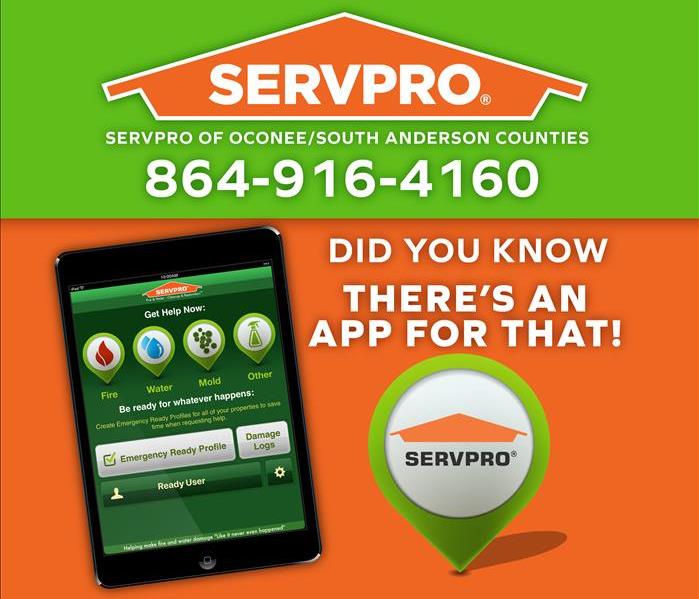 Find the App on Your Google or Apple Store
Find the App on Your Google or Apple Store
When disaster strikes your business, having a plan in place ahead of time for what you will do can make all the difference in whether your business survives the event. The majority of businesses that come out stronger on the other side of an emergency are the ones that pre-planned for one. That’s where SERVPRO’s Emergency Ready Plan (ERP) can help give you, your employees and customers peace of mind. You can trust that whatever might happen to disrupt daily business will only be temporary. With our Emergency Ready Plan, your business will be able to minimize interruption because you’ll know what to do and what to expect if any-sized disaster strikes. This is important to timely mitigation and can help minimize how water and fire damage can affect your business.
Why Use the SERVPRO Emergency Ready Plan?
• A no-cost assessment of your facility: This means there is no need to allocate funds, giving you a great value at no cost.
• A concise Profile Document that contains only the critical information needed in the event of an emergency: It takes just a short time to complete the profile but could save long hours of time and effort if ever needed.
• A guide to help you get back into your building following a disaster: Having an immediate plan of action can help minimize the downtime to your business in an emergency.
• Establishes your local SERVPRO as your disaster mitigation and restoration provider: You have a provider that is recognized as an industry leader and is close by.
• Identification of the line of command for authorizing work to begin: You can save time and money as we begin the work of mitigating the damage.
• Provides facility details such as shut-off valve locations, priority areas and priority contact information: You’ll have a quick reference of what to do, how to do it and who to call ahead of an emergency so you are “Ready for whatever happens.”
• Easier insurance claims process: SERVPRO will help you navigate the insurance claims process and coordinate the necessary paperwork for a quicker, easier experience.
Use Our Emergency Ready Plan Mobile App
You can download the “SERVPRO Ready Plan” mobile app on your iPhone or Android device from the respective App Store. You may also sign up online to create your Emergency Ready Plan, or contact your local SERVPRO to begin creating ERP’s for all your properties.
New to the Emergency Ready Plan? Begin setting up your Emergency Ready Plan by following the link below. You’ll need to give details such as full name, mobile number, email address and set up a password for your profile.
www.ready.SERVPRO.com/Account/Register
Electric Heater Safety
12/21/2021 (Permalink)
As winter begins to hit and temperature begins to drop, you may choose to buy a space heater for warm up your home, apartment, or work space. Space heaters are a good alternative if you do not want to turn up your thermostat to heat up your home. Here are some tips that you can use to prevent any disaster caused by a space heater:
- Leave the heater on level floor, don’t place on carpet - it can overheat and start a fire.
- Do not use in bathroom, unless it is designed for it - moisture can damage the heater.
- Keep three feet away from flammable materials and out of the way of children and pets.
- Should always be plugged directly into wall outlet, don’t use with extension cord because it can cause overheating.
- Don’t leave heater unattended, make sure to unplug when not in use.
- Install smoke alarms on every floor.
Space heaters, if not used correctly, can cause fire damage to your property. Give SERVPRO of Oconee/South Anderson Counties a call today at 864-916-4160.
Scared of frozen pipes
12/21/2021 (Permalink)
Below a few steps, you can take to help decrease your chances of dealing with pipe bursts as a result of the cold weather:
- Leave the Heat On - This may seem self-explanatory, but if you’re away overnight or gone for long periods of time, setting your indoor temperature no lower than 55°F helps ensure your pipes aren’t as exposed to the cold.
- Insulate Pipes - Though you should always ensure your attic and crawl space are properly insulated year-round, a makeshift quick, and inexpensive way to insulate your pipes would be to wrap pipes in heat take or heat cables with thermostat control. This will work in a pinch, but we recommend properly insulating these high-risk areas.
- Seal Cracks and Opening - To prevent drafts, seal or caulk cracks and openings around windows, doors, dryer vents, water pipes. and sill plates.
Let Faucets Drip - Letting cold water drip from a faucet helps to keep water flowing throughout the pipes. As the water flows, even if it’s just a trickle, it helps to prevent pipes from freezing.
If you do find yourself in a water issue due to busted frozen pipes, make sure to call SERVPRO of Oconee/South Anderson, our water damage professionals are trained and certified to handle any disaster you find yourself in during these colder months.
Hoarding Clean up
12/21/2021 (Permalink)
What is Hoarding?
Hoarded items are often things others would throw away or look at as junk or garbage such as old newspapers, junk mail or packaging. Hoarding can lead to homes filled with extreme clutter to full capacity from years of accumulation, making living conditions unsanitary and crowded. Bugs, fleas, rats and other vermin may be present, at which point an exterminator would need to be called. At times, hoarding may spread to outside the home as well, to storage facilities, or even the garage or yard.
How can SERVPRO of Oconee/South Anderson Help?
We communicate with the insurance company regarding the customer's contents coverage, and after approval, contents can be packed out and possibly cleaned, dried, and stored in our temporary storage in our warehouse so work on the fire or water loss can begin. Another way SERVPRO of Oconee/South Anderson encounters hoarding jobs is through calls from landlords, caseworkers, real estate agents, or family members, often after the death of a loved one. In these situations, the crew will see if they should look for any items of importance while they clean the job. Sometimes, family members will come and try to help the hoarder sort through their contents as well. Each case is very different, and hoarding jobs are often sensitive situations, but SERVPRO of Oconee/South Anderson is here to help make it “Like it never even happened.” If you encounter a hoarding situation at one of your properties.
Give us a call at 864-416-9160
Storm Damage
8/20/2021 (Permalink)
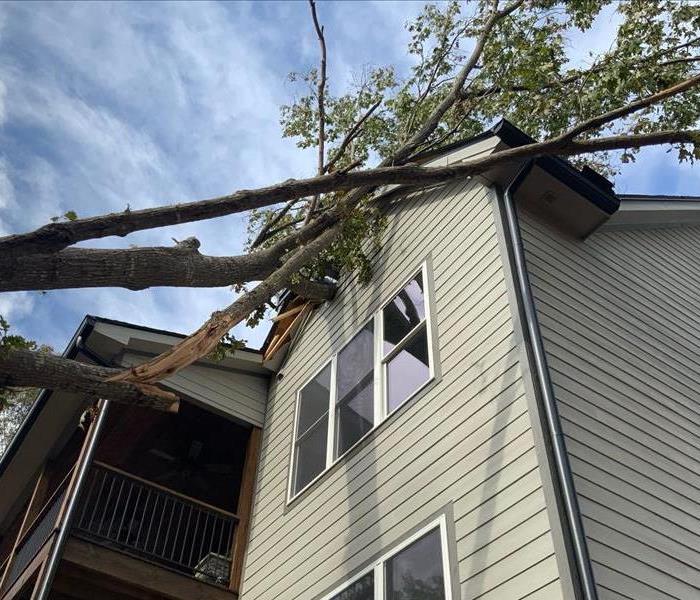 This house was hit by a tree, which caused water damage to the inside of the structure
This house was hit by a tree, which caused water damage to the inside of the structure
While water damage is typically associated with events like flooding or plumbing malfunctions, heavy rain can also cause its own set of issues regarding water damage around the house.
While any level of moisture can cause damage, heavy rain is considered rainfall at rates over 0.3 inches per hour and can work its way into much smaller vulnerabilities in your home. To help you better prepare and avoid water damage, we have put together a list of how these rapid rainfall rates can cause issues.
How Heavy Rains Cause Household Water Damage
Backup of clogged gutters
Clogged gutters can cause significant damage to your home after heavy rains. If there is debris in the gutters, it will be difficult for water to drain away, which can then result in leaks from puddles as the water is left standing against the roofline.
Leaks around windows and doors
Windows and doors are supposed to be sealed against the elements, but as their weatherproofing ages, it can deteriorate as well. When heavy rains roll through, water can find its way into minuscule cracks and cause damages.
Poor drainage around the foundation
If your home is at the bottom of a hill or does not have adequate drainage around the foundation, heavy rains can build up against the base of your home and lead to leaks in your basement or crawl spaces.
Leaks in and around the roof
Roof leaks are one of the leading consequences of heavy rains, and they can sneak up suddenly. All it takes is for a shingle to be scraped away or a weak spot to form and rainwater can begin seeping in as it falls.
Malfunctioning of a sump pump system
For homes with sump pumps, doing regular maintenance and checking for issues is key—otherwise, the pump system can get overwhelmed and will not be able to effectively move water away from the home.
Leaks around chimneys and skylights
Houses with chimneys and skylights tend to be more vulnerable to heavy rains than homes without them. While they are nice features to have, the seals where they meet with the roof can grow vulnerable over time and become overwhelmed when rainfall is heavy.
Remember to stay safe and get excess water cleaned up professionally to minimize the chance of mold growth. Our Team at SERVPRO of Oconee/south Anderson Counties is ready to assist at a moment's notice with any of your water mitigation emergencies. Give our team a call at 864-916-4160.
Three types of water damage
8/20/2021 (Permalink)
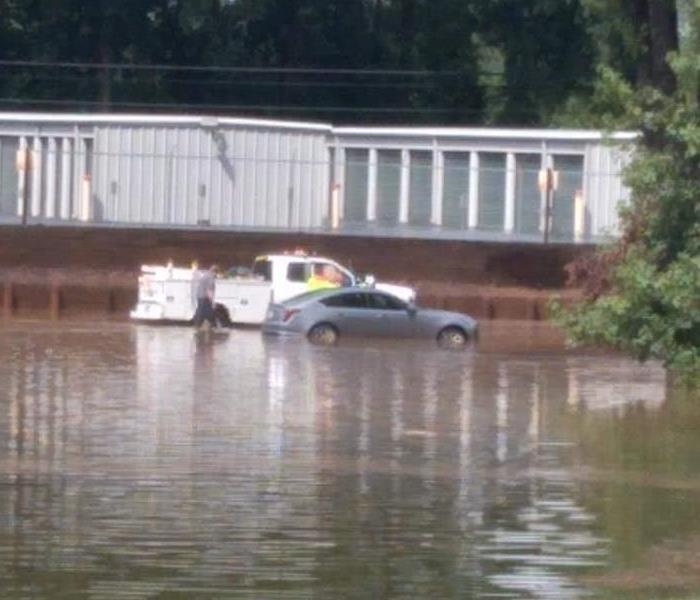 This flood was caused by a recent storm in Oconee County
This flood was caused by a recent storm in Oconee County
The phrase “water damage” is an umbrella term that describes a variety of different situations and conditions. Every incident involving water is unique and its resulting water damage varies. It may come as a surprise that even the water itself can be categorized into a variety of classifications. The Institute of Inspection, Cleaning, and Restoration Certification details three different “Categories of Water” that are involved in water damage in homes and businesses alike. In this blog, we’ll break down these three categories of water, which can help you assess the severity of any water damage that should occur in your home or business.
The IICRC’s 3 Categories of Water
The three water categories presented by the IICRC in its “S500 Standard for Professional Water Damage Restoration” article aim to classify water by its contamination level, “considering both its originating source and quality after it contacts materials present on the job site.” The document also asserts that the amplification of the water’s contamination level can be increased or decreased by both time and temperature.
Category 1- Clean Water
Water that is classified as Category 1 is commonly referred to as “clean water,” as the water’s source is sanitary and does not pose any risks from exposure. Category 1 water examples may include melting ice or snow, rainwater, and broken water supply lines. While it does not appear as though Category 1 water poses a significant risk, this water can deteriorate depending on how long microorganisms remain wet after exposure and the environment’s temperature. If the water develops an odor, its sanitation has likely worsened, dropping its classification to category 2.
Category 2- Gray Water
When water falls under Category 2, it is significantly contaminated. Upon exposure or consumption, humans can experience symptoms ranging from discomfort to sickness. A wide variety of circumstances fall under Category 2, including common household water damage situations like dishwasher discharge, washing machine overflow, and toilet bowl overflows. Category 2 water also includes a few surprises, such as punctured water beds and broken aquariums. Like Category 1 water, this water can also deteriorate to Category 3, also known as “black water.”
Category 3- Black Water
The most severely contaminated category of water according to the IICRC, Category 3 water, is commonly known as “black water.” Water of this category is “grossly contaminated,” according to the IICRC, and sometimes contains pathogens, toxins, or other “harmful agents.” Category 2 water is known to occasionally cause health effects, but upon contacting or consuming Category 3 water, humans can experience very serious health effects. Types of water that fall under this category include sewage, flooding that originates from seawater and rivers, as well as wind-driven rain from tropical storms or hurricanes. It is important to understand that Category 3 water is capable of carrying harmful substances like toxins and pesticides, so it is best to allow a professional to handle the situation.
We Have the Expertise That You Need
Our team of water damage professionals at SERVPRO Of Oconee/South Anderson Countiesabides by the IICRC’s S500 Standards, as every team member undergoes training with SERVPRO Industries Inc., an -IICRC-approved school. When you call us at (864) 916-4160, our team will arrive onsite immediately, identify the category of water damage onsite, and tailor the water damage restoration services to your home or business’ specific needs in accordance with industry guidelines.
Unpleasant Odors
8/20/2021 (Permalink)
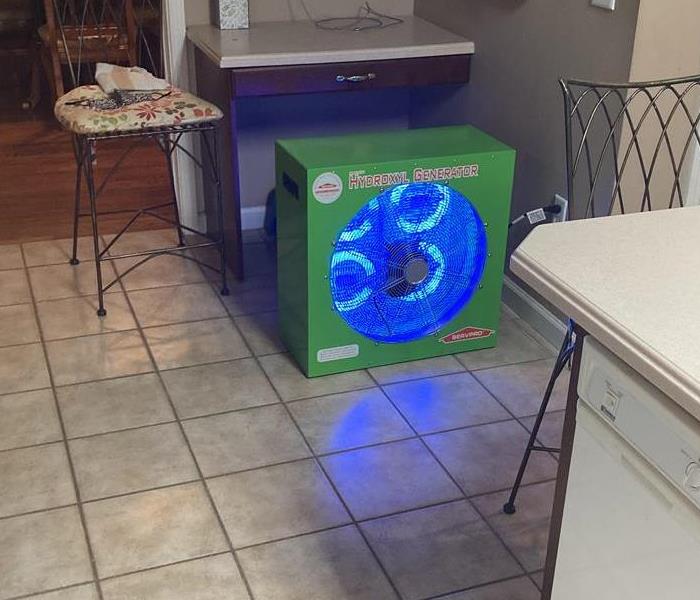 This Hydroxyl is treating a kitchen that had a small fire.
This Hydroxyl is treating a kitchen that had a small fire.
Odors from smoke, pets, decomposition or mold can cause lingering odors in your home or business. A simple surface clean doesn’t necessarily get rid of these smells. SERVPRO of Oconee/South Anderson Counties provides specialized services that can rid your home or business of offensive odors left by smoke, mold or other sources. Our professionals do not cover up lingering odors with a fragrance; they seek out and remove the sources of the odor. Once the source is found, we use SERVPRO’s own proprietary line of cleaning products to treat and prevent the odor from returning. Any restorable item in affected areas will also be professionally cleaned and deodorized, including furniture, draperies and upholstery, electronics, art, flooring, walls, ceilings, HVAC air ducts, and more. Along with our proprietary line of cleaning products SERVPRO of Oconee/South Anderson Counties uses various techniques and equipment to treat odors. These techniques are capable of penetrating surfaces to neutralize an unpleasant odor thoroughly. Some of the tools we use include:
- Ozone Generator: The Ozone Generator is one of the quickest ways to eliminate odors from a home or office. We use the Ozone Generator to oxidize odor and eliminate odors from mold, mildew, pets, nicotine, smoke and more without the use of chemicals. Though the room being treated cannot be occupied while in use, the generator works quickly to clean, sanitize and remove offensive odors.
- Hydroxyl Generator: The Hydroxyl Generator has several benefits that the Ozone Generator does not. The main benefit is that the room being treated can be occupied during the deodorization process; though it does work slower. The Hydroxyl Generator can be used to treat fire and smoke, as well as biohazard jobs, water damage, crime scene situations, and animal odors.
- Air Filtration Device: This piece of equipment, also known as an air scrubber, is used to remove airborne contaminants during water, fire, smoke, mold, and sewage restoration work. These work by pulling air through HEPA filtration to remove airborne particles from the air. This helps clean the air and remove odors.
Whether you are a building manager who needs an apartment cleaned for the next tenant or homeowner who wants to get your home ready for sale, getting rid of offensive odors is a high priority. Fire, water, or mold damage, or just a stubborn odor that refuses to go away, SERVPRO of Oconee/South Anderson Counties is here to help make it “Like it never even happened.”
Board up
8/20/2021 (Permalink)
SERVPRO of Oconee/South Anderson Counties is proud to offer emergency board-up services. If your home has experienced a fire, or other major damage causing it to be unsafe or unsecure; we’re happy to help. Secondary damage, caused by Fire Departments attempts to extinguish the flames can leave you with broken windows, missing doors or portions of walls that can allow unwanted guests to enter your home. After you’ve experienced a loss in your home or business, it’s important to protect what remains salvageable. We provide the materials and manpower to close off any access to the structure.
- Protect electronics and other valuables. Depending on the extent of the fire damage, you may be able to restore some electronics or other valuable property to working condition.
- Keep out the elements. If the structure of your property has sustained extensive damage, you should try to keep the elements out to prevent additional damage. Exposure to additional water, wind, or sunlight can compound the damage caused by smoke residue and soot.
- Limit soot damage. It is generally a good idea to reduce foot traffic on the scene of a recent fire. When soot gets embedded into carpeting or upholstery, it can be much more difficult to restore these materials to a pre-fire condition.
Causes of Indoor Flooding
8/20/2021 (Permalink)
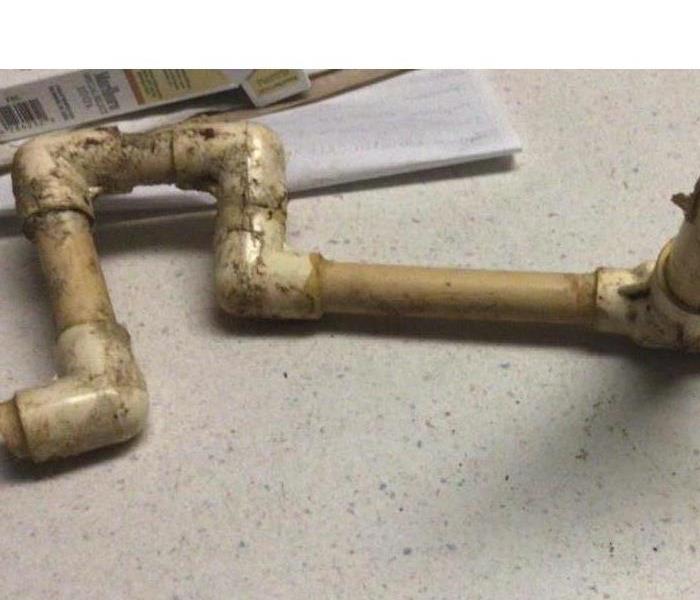 This is a picture of a pipe that broke on the water heater.
This is a picture of a pipe that broke on the water heater.
Water damage usually has one major leading cause: indoor flooding. Some of the most common causes of indoor flooding are:
- Leaky or Broken Pipes: The most obvious cause of indoor flooding is leaky or broken water pipes. Pipes can burst from changes in water pressure or even a faulty setup, but regardless of the cause, pipe problems often cause a ton of damage. Leaky pipes are usually a warning sign of more problems to come. Hidden floods caused by broken pipes in your walls can even create the perfect environment for microbial growth.
- Faulty Washing Machine Hose: The most common problem with watching machines are faulty hoses. A leak in your intake hose can worsen over time and can cause flooding in your home.
- Water Heaters: Even a small leak in your water heater can cause major flooding due to its endless flow of water. Make sure to inspect your water heater on a regular basis, keeping up with maintenance to ensure it doesn’t spring a leak.
- Clogged Sewer or Drain Lines: The flow of water to and from your house can be disrupted when you have clogged sewer or drain lines. Some clogs might be benign, allowing for a slow drain that is merely an inconvenience. But those clogs can get worse over time. The clog can cause your sinks, toilets, and showers to overflow with water, resulting in major damage. This can even include backed-up sewage, causing a hazardous environment for anyone or anything that comes in contact with the affected water.
If you find flooding inside your home, call us and we will be there to help.
Air Duct Cleaning
8/20/2021 (Permalink)
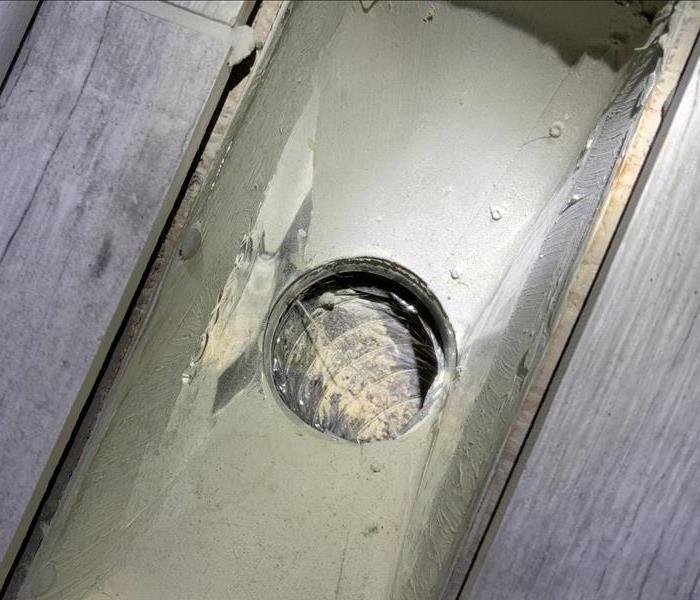 This vent is full of dirt
This vent is full of dirt
Did you know that air ducts are typically the number one reason for poor indoor air quality? You can’t see them, so they’re often forgotten about. Regular inspection and maintenance could help prolong their lifespan and improve your air.
Air ducts move most of the air throughout your home, bringing warm and cold air from the HVAC unit to various areas. While they’re moving this air they’re collecting dust, pollen, dirt and debris, odors and other contaminants.
By having your air ducts professionally cleaned you can:
- Increase the energy efficiency of your HVAC unit
- Reduce the potential for mold growth
- Eliminate offensive odors
Why is PPE so Important?
8/20/2021 (Permalink)
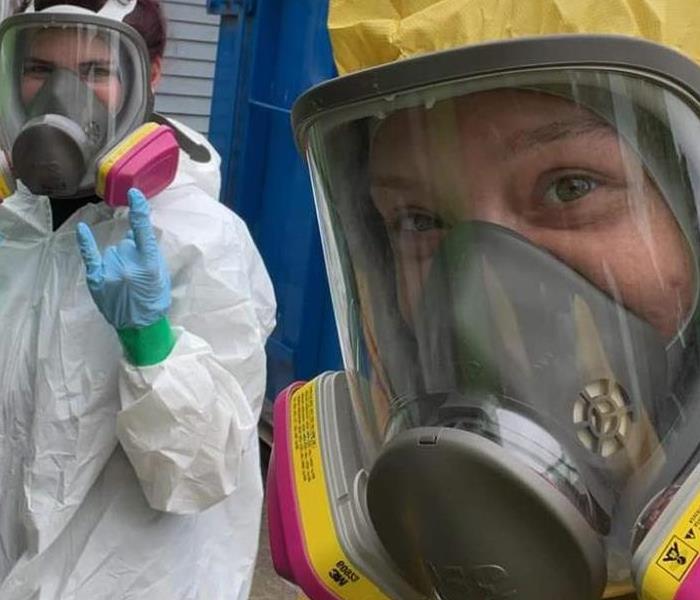 Two workers getting ready to start a bio job.
Two workers getting ready to start a bio job.
Why is Personal Protection Equipment so important?
Personal protective equipment, commonly referred to as "PPE", is equipment worn to minimize exposure to hazards that cause serious workplace injuries and illnesses. These injuries and illnesses may result from contact with chemical, radiological, physical, electrical, mechanical, or other workplace hazards. Personal protective equipment may include items such as gloves, safety glasses and shoes, earplugs or muffs, hard hats, respirators, or coveralls, vests and full body suits.
At SERVPRO of Oconee/South Anderson Counties we always wear full PPE, to ensure safety from and to limit the exposure of any hazards.
So no, we aren't wearing suits to look like marshmallows or a big huge banana, we are doing it for protection!!
Toilet Back Up
8/20/2021 (Permalink)
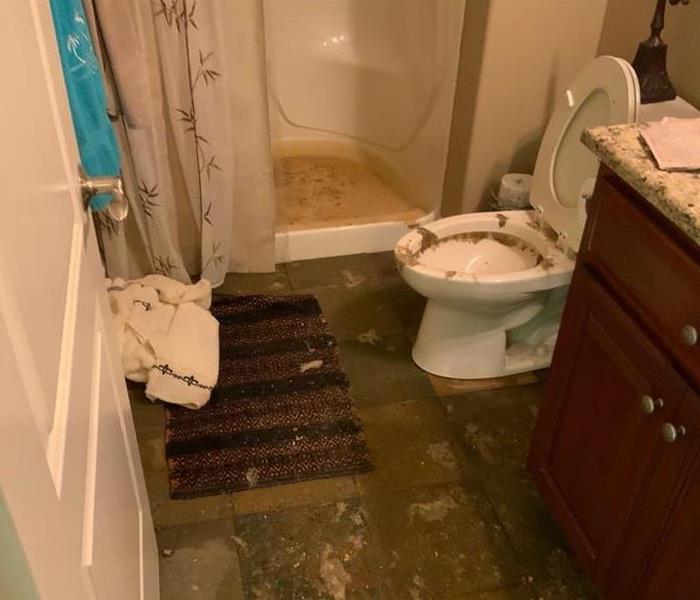 This bathroom encountered a sewage back up
This bathroom encountered a sewage back up
What Causes a Toilet Overflow?
Several different events can trigger a toilet to overflow, including a clogged drain, a blocked vent, and sewage complications.
A clogged or blocked drain prevents proper flushing, causing the toilet to overflow. In this situation, plunging the toilet may relieve the problem.
Every time you flush, air is pumped and needs replacing from the vent pipe. If the vent pipe is blocked, proper flushing isn’t possible and can eventually result in a toilet overflow. This issue usually requires the help of an experienced plumber.
Finally, two issues related to sewage, a clogged sewer line and a full septic tank, can be the catalyst of a toilet overflow. A clogged sewer line occurs when the sewer line becomes blocked by items ranging from tree roots to sanitary wipes. A full septic tank can be problematic, as excess water will have nowhere to go but back up into your home, potentially resulting in a toilet overflow.
Dealing with Mold
2/8/2021 (Permalink)
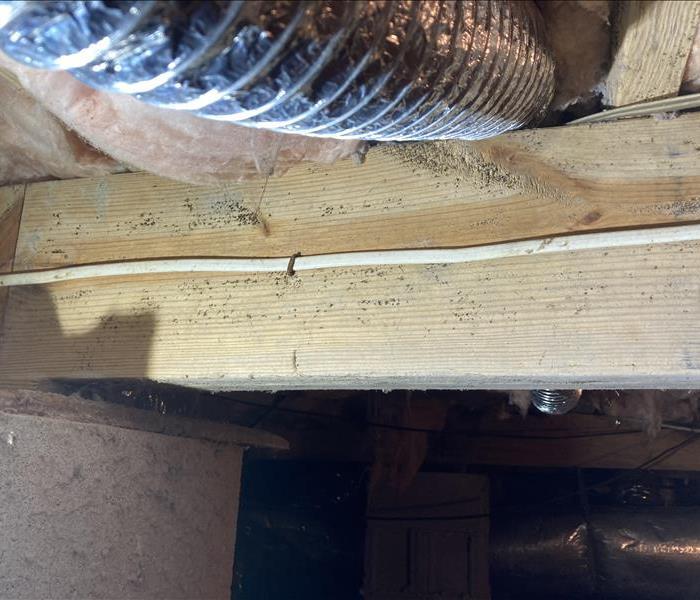 Crawlspace with Mold
Crawlspace with Mold
When there is water in your home, mold can quickly become an issue. It can cause health effects and damage to your property. SERVPRO of Oconee and South Anderson Counties has the training, protective gear, and specialized equipment to handle your mold problem.
Call SERVPRO of Oconee and South Anderson Counties
The mold cleanup and restoration process begins when you call us. One of our employees will ask a series of questions to help determine the necessary equipment, resources, and personnel needed.
Assessment
Your property will be carefully inspected for signs of mold using various technologies to detect mold and hidden water sources. Mold feeds on cellulose and water and can be hidden from plain view.
Containment
Different containment procedures will be placed to prevent the spread of mold, like negative air chambers to isolate the contaminated area with physical barriers and negative air pressure to keep the mold spores from spreading during the cleanup process.
Air Filtration
Specialized filtration equipment captures microscopic mold spores out of the air. SERVPRO of Oconee and South Anderson Counties technicians use powerful air scrubbers and HEPA vacuums to prevent the spread of these mold spores while the mold remediation is in progress.
Removing
The process of mold remediation depends on the amount of mold growth and the type of surface it's on. Anti-fungal and antimicrobial treatments will be used to eliminate mold colonies and help prevent new ones from forming. Removing and disposing of mold-infested porous materials, like drywall and flooring, may be necessary.
Cleaning
SERVPRO of Oconee and South Anderson Counties cleans your furniture, decorative items, curtains, and other restorable items affected by mold. We use a variety of cleaning techniques to clean and sanitize your belongings.
Restoration
Depending on the level of mold damage, some building materials may have to be removed. Restoration may involve minor repairs or major repairs such as reconstruction.
24 Hour Emergency Water Damage Service
1/1/2021 (Permalink)
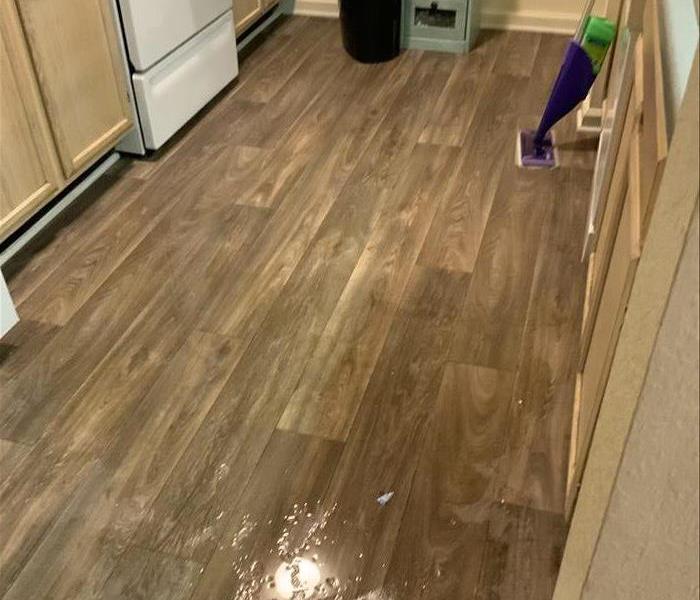 water on kitchen floor due to sewage back up
water on kitchen floor due to sewage back up
SERVPRO of Oconee and South Anderson Counties is available 24 hours a day for water emergencies, large or small. When you are dealing with water damage, immediate action is crucial. A delay of just a few hours can greatly increase the severity of the water damage.
We Answer the Phone Ready to Help
Call Today 864-916-4160
We understand that when you call us, you may be feeling confused, stressed, and vulnerable. You need an expert to guide you through this crisis. SERVPRO of Oconee and South Anderson Counties has the specific water damage training and experience to help you through this tough time. We specialize in water damage restoration—in fact, it's the cornerstone of our business.
What to Expect
When you call, we will ask several questions regarding your water damage emergency. These questions will help us determine what equipment and resources to bring, including how many trained SERVPRO Professionals may be needed.
Our SERVPRO Representative will ask several questions:
- Your name and contact information
- Your insurance information (if applicable)
- The street address of the water-damaged home or business
- When did the flooding or water damage occur?
- What caused the water damage (if known)?
- Is there electricity available (on-site)?
About SERVPRO of Oconee and South Anderson Counties
SERVPRO of Oconee and South Anderson Counties specializes in the cleanup and restoration of residential and commercial property after a fire, smoke or water damage event. Our staff is highly trained in property damage restoration. From initial and ongoing training at SERVPRO’s corporate training facility to regular IICRC-industry certification, rest assured our staff is equipped with the knowledge to restore your property.
Faster to your Oconee and South Anderson County Water Damage Event
1/1/2021 (Permalink)
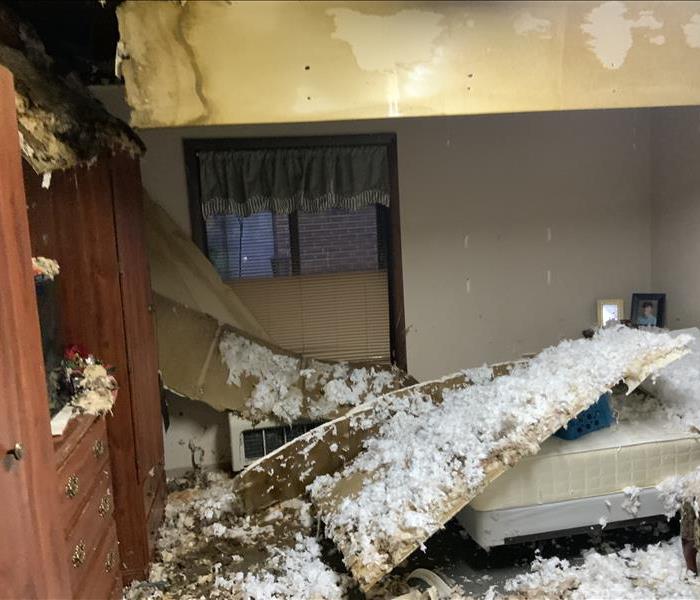 Ceiling fell through due to sprinkler system being broken
Ceiling fell through due to sprinkler system being broken
Flooding and water emergencies don’t wait for regular business hours and neither do we. Oconee and South Anderson Counties provides emergency cleaning and restoration services 24 hours a day, 7 days a week—including all holidays.
Faster To Any Size Disaster
Flooding and water damage is very invasive. Water quickly spreads throughout your home and gets absorbed into floors, walls, furniture, and more. SERVPRO of Oconee and South Anderson Counties arrives quickly and starts the water extraction process almost immediately. This immediate response helps to minimize the damage and the cleaning and restoration costs.
Need Emergency Service? Call Us 24/7 –864-916-4160
Water Damage Timeline
Within Minutes
- Water quickly spreads throughout your property, saturating everything in its path.
- Water is absorbed into walls, floors, upholstery, and belongings.
- Furniture finishes may bleed, causing permanent staining on carpets.
- Photographs, books, and other paper goods start to swell and warp.
Hours 1 - 24:
- Drywall begins to swell and break down.
- Metal surfaces begin to tarnish.
- Furniture begins to swell and crack.
- Dyes and inks from cloth and paper goods spread and stain.
- A musty odor appears.
48 Hours to 1 Week:
- Mold and mildew may grow and spread.
- Doors, windows, and studs swell and warp.
- Metal begins to rust and corrode.
- Furniture warps and shows signs of mold.
- Paint begins to blister.
- Wood flooring swells and warps.
- Serious biohazard contamination is possible.
More Than 1 Week:
- Restoration time and cost increase dramatically; replacing contaminated materials and structural rebuilding may be extensive.
- Structural safety, mold growth, and biohazard contaminants pose serious risks to occupants.
About SERVPRO of Oconee and South Anderson Counties
SERVPRO of Oconee and South Anderson Counties specializes in the cleanup and restoration of residential and commercial property after a fire, smoke or water damage event. Our staff is highly trained in property damage restoration. From initial and ongoing training at SERVPRO’s corporate training facility to regular IICRC-industry certification, rest assured our staff is equipped with the knowledge to restore your property.
Mold Damage Tips
11/11/2020 (Permalink)
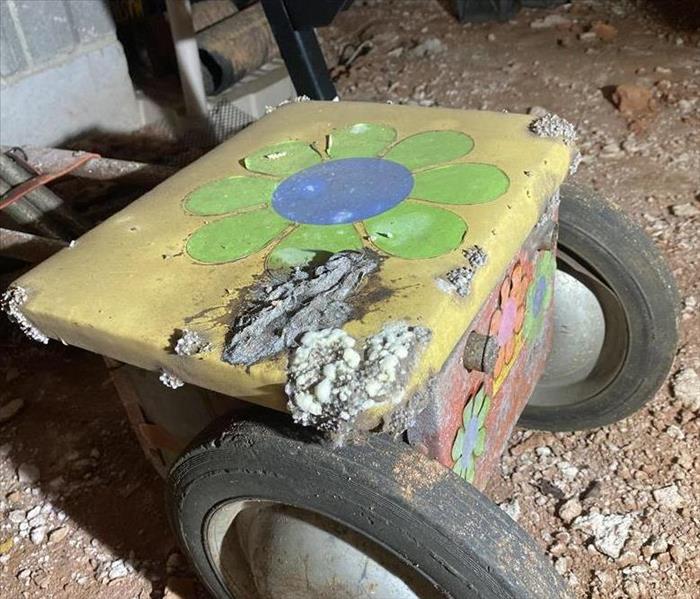 Dont let mold take your personal belongings
Dont let mold take your personal belongings
Mold could be lurking in your home and you wouldn't even realize it. When mold is disturbed, it can release microscopic mold spores. When this happens mold can circulate inside your home using your HVAC system and any fans you have on. This makes it so the affected areas grow and become larger. Whether you can see it or not, here are some tips on what to do!
What Should You Do:
- Stay out of affected areas.
- Turn off the HVAC system and ALL fans.
- Contact SERVPRO of Oconee/South Anderson for mold remediation services.
What Should You Not Do:
- Don’t touch or disturb the mold.
- Don’t blow air across any surfaces with visible or suspected mold growth.
- Don’t attempt to dry the area yourself.
- Don’t spray bleach or other disinfectants on the mold
Call SERVPRO of Oconee/South Anderson today for your mold remediation needs.
864-916-4160





 24/7 Emergency Service
24/7 Emergency Service
